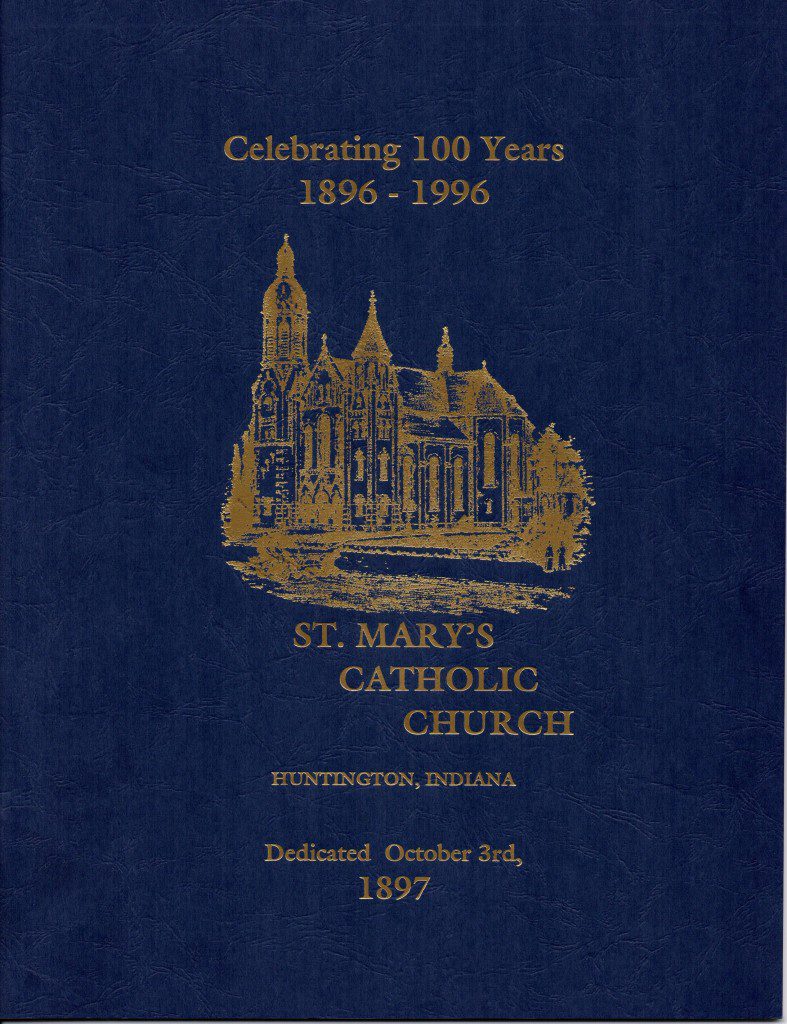
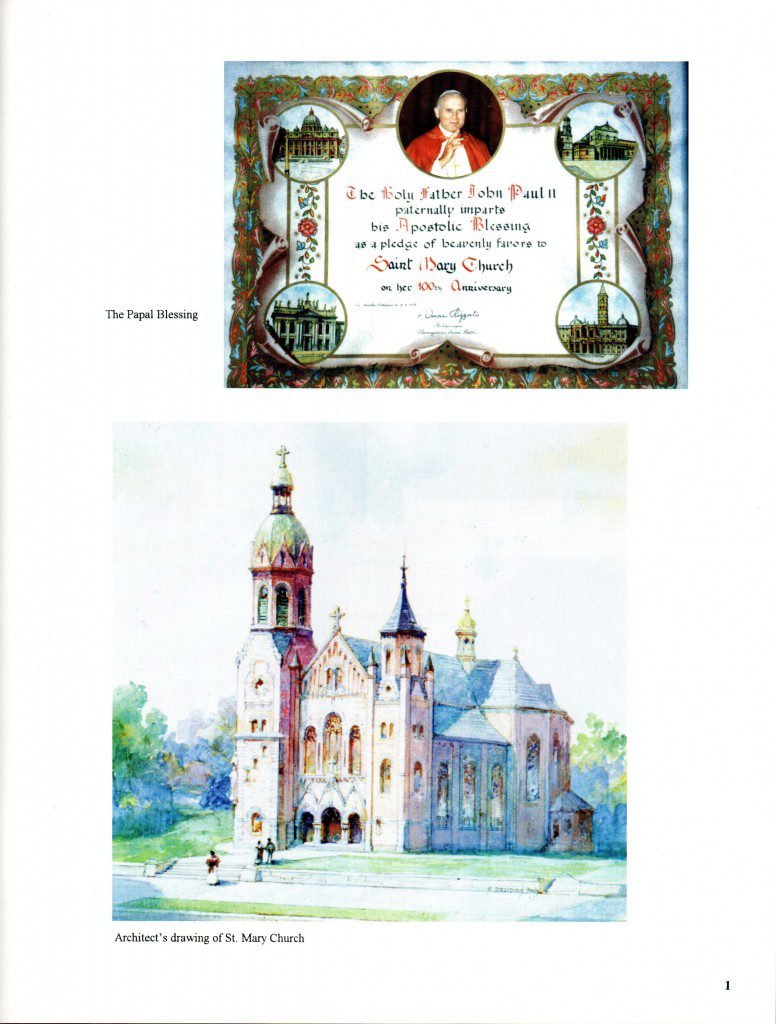
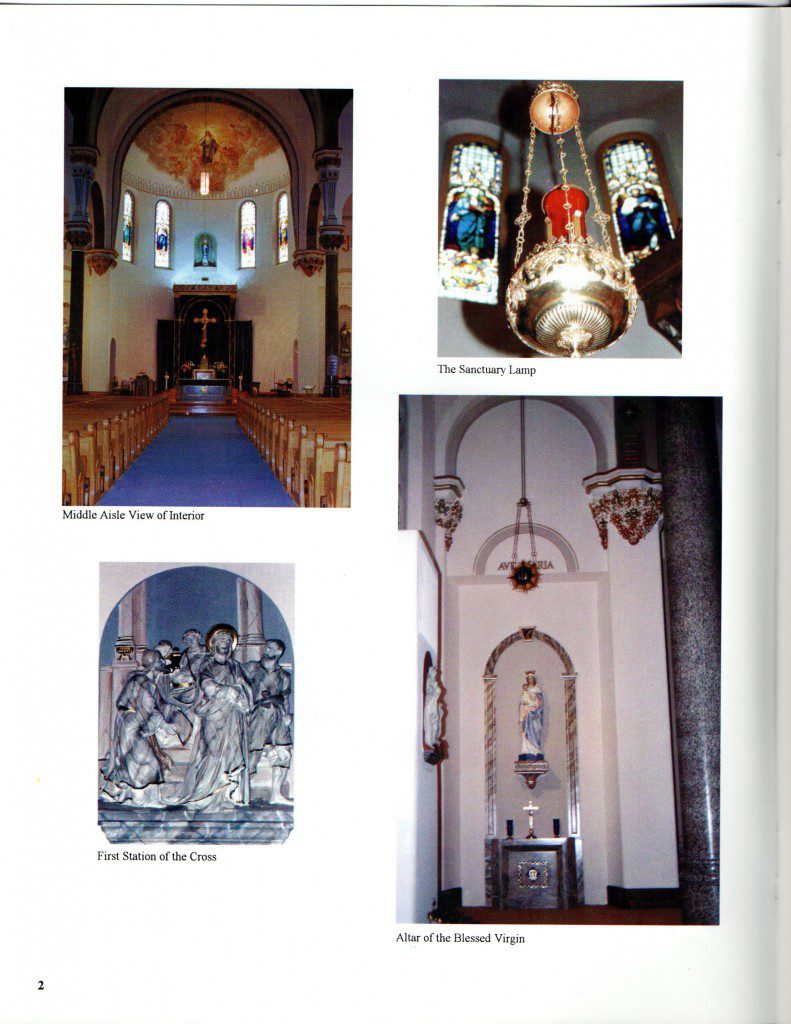
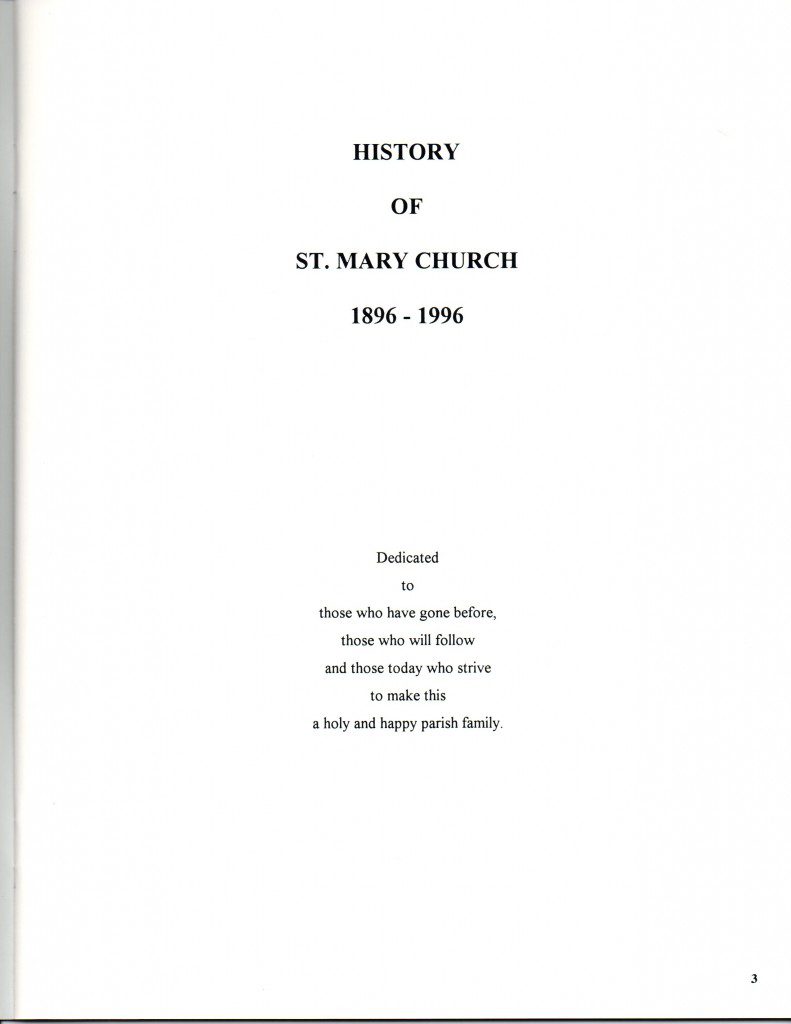
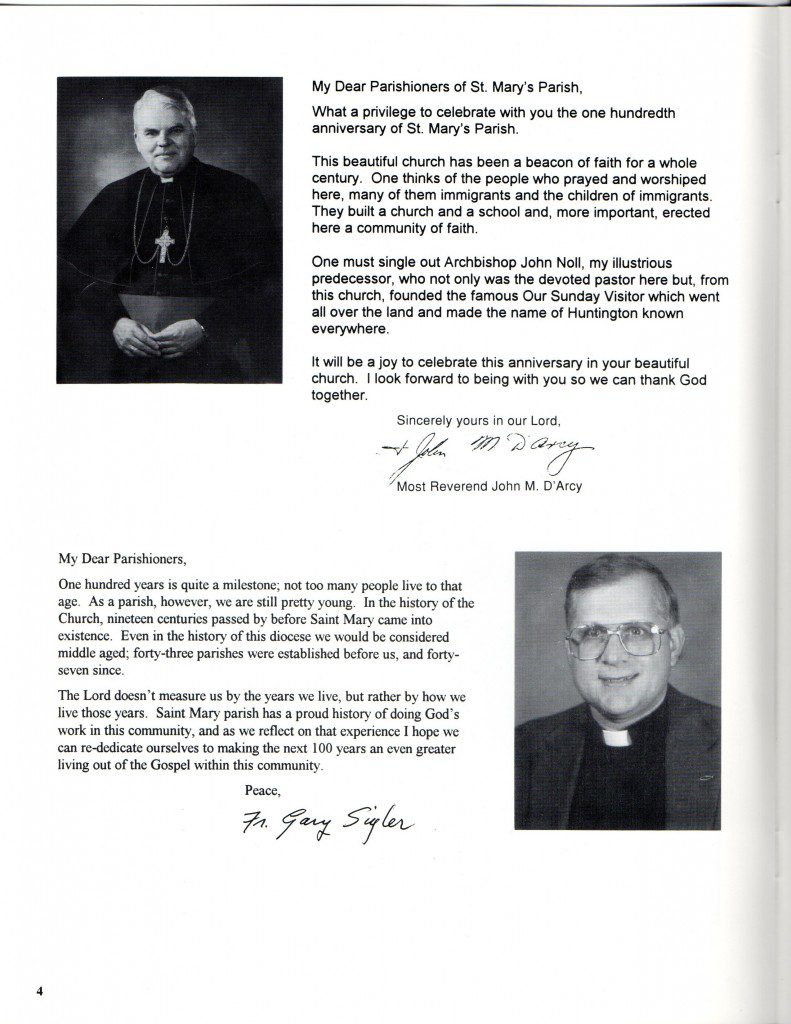
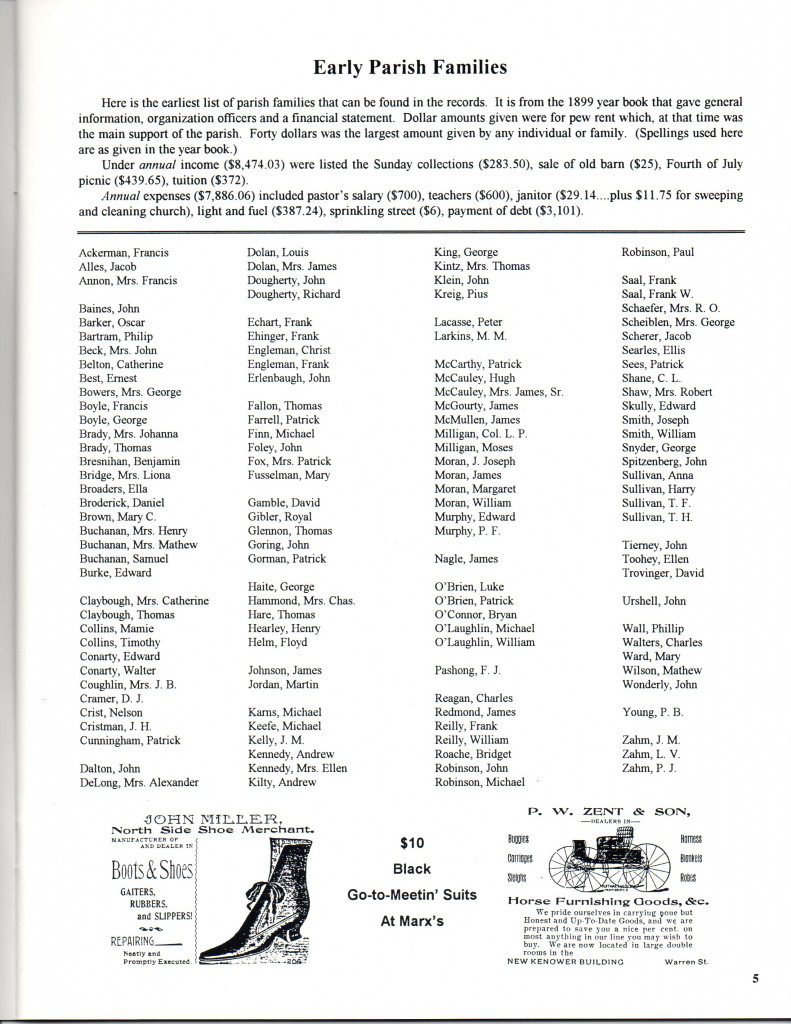
by Loretta Manoski & Murray Hubley (1996)
The Miami Indians
The first European to have ventured through the Wabash Valley was probably the French explorer Robert Cavalier, Sur de LaSalle in about 1670. It was probably another decade before the first Catholic missionary reached the Wabash River and that was the French Jesuit Father Jacques Marquette.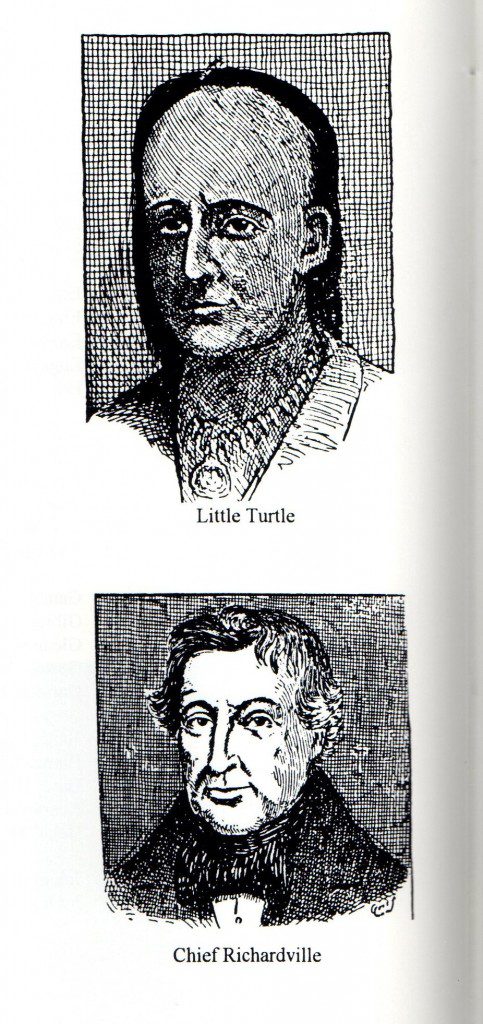
The land in this part of what is now Indiana, southern Michigan, much of Ohio and Illinois down to the Ohio River, was controlled by the Miami Indians. The Miami had migrated down from the Hudson Bay area to the western shores of Lake Michigan generations before the appearance of the French. They then moved east along the rivers and lakes as far as Lake Erie and the Ohio River. Until this time the Iroquois had been dominant in those places. The fierce Iroquois were the ancient and hated enemies of the Miami.
The Miami then in a confederation with other Great Lakes region Indians — The Ottawas, the Chippewas, The Potawatomis and the Mingo — fought a war of nearly one hundred years against the Six Nations of the Iroquois. The continuing hostilities decimated the populations on both sides — reducing the number of Indians in the Great Lakes region to about a third of what it had been. In the years that followed, remnants of many other Indian tribes, fleeing both the Iroquois and the Colonials, had settled in the relatively protected area of the Miamis. These tribes included the Delaware and Shawnee in large numbers and a few Mohicans.
From the time that the Miami and the other tribes, notably the Potawatomis, had contact with the French until 1847, the Indians were involved with the French, the British and the Americans in a bid for control of the Great Lakes region. The French and British sought friendly relations with the tribes during their imperial wars which spilled over into the North American Continent. Each wished to ally themselves with the Indians in order to oust the other from the territory.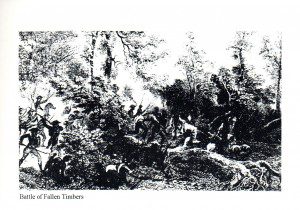
The Wabash River had always been a valuable link of communication between Louisiana and Canada. The French explorers discovered a route which would connect French Quebec with French New Orleans at the mouth of the Mississippi. They found that route which began at Lake Erie up the Maumee River to a short portage near the confluence of the Maumee with the St. Mary’s and St. Joseph’s rivers to the Wabash River down to the Ohio and then to the Mississippi and New Orleans.
The British hoped to sever this link and gain a valuable fur trading region. And the Americans wanted to expand westward and settle the new territory.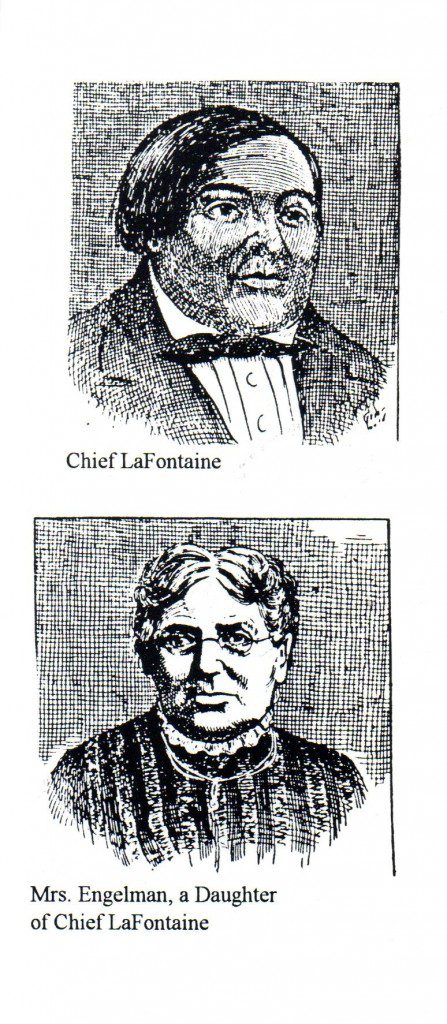
But the Miami Confederation, formed years earlier to defend the region from the fierce Iroquois, went to war with the Colonials, who attempted to move into their lands. This made the Indians allies of the English.
The Miami war chief, Little Turtle, twice led the strongest Indian armies ever assembled and employed in battle on the North American Continent against the Americans. He routed General Josiah Harmar’s 1,453 troops of federal regulars and militia in October 1790.
The following year General Arthur St. Clair arrived in the Northwest Territory to build a series of forts between the Ohio River and Lake Erie. On Nov. 4, 1791, with 2,500 warriors of the Miami Confederation under his command, Little Turtle decimated the more than 1,500 well-trained federal regulars under the command of Gen. St. Clair on the Ohio bank of the Wabash River at what is now Fort Recovery, Ohio.
It wasn’t until two years later after General Anthony Wayne came to the Old Northwest in 1793 that Little Turtle was subdued at Fort Recovery and at Fallen Timbers, near present Maumee, Ohio. In August 1795, he and a number of other tribal chiefs of the Confederation signed the Treaty of Greenville, by which the Indians ceded to the U.S. much of Ohio and parts of Illinois, Indiana and Michigan.
Early Catholicism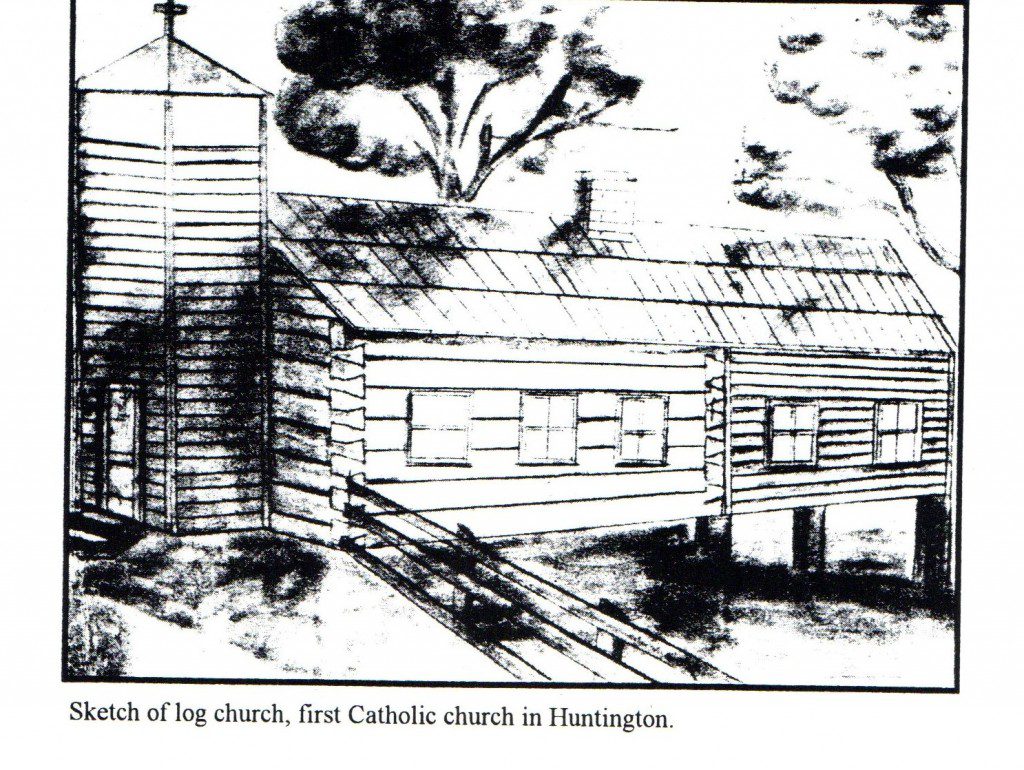
Explorers, priests and fur traders from Catholic France traveled regularly through the Huntington area and had a definite effect promoting Catholicism. History shows that Jesuit priests visited in the 17th century. The first record of Mass being said here was one celebrated by Father Stephen Badin of Bardstown, Kentucky in 1834, probably on the present site of St. Mary Church.
The only known Catholic families in the area at that time were those of Daniel Johnson, Patrick Johnson, Michael Kennedy, Martin Roche and Michael Doyle. Masses continued to be said in private homes as priests were available.
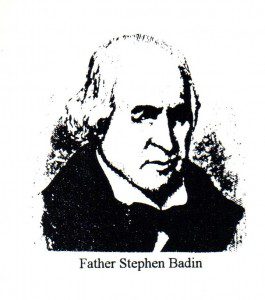 In 1832 work began in the local area on the Wabash & Erie Canal. It brought an influx of laborers, many of Irish or German descent. By 1838 a Catholic Church, St. Patrick’s had been built at Lagro which was a center of Irish settlers.
In 1832 work began in the local area on the Wabash & Erie Canal. It brought an influx of laborers, many of Irish or German descent. By 1838 a Catholic Church, St. Patrick’s had been built at Lagro which was a center of Irish settlers.
German Catholic emigrants also continued to grow in numbers. In 1840 they organized to build a church on property that had been given to them by Chief Richardville. First Mass was celebrated in the little log church on August 15, 1843 by Father Julian Benoit. Priests from Lagro and Fort Wayne continued to provide Mass regularly until 1857 when the first resident pastor, Father Schippert, arrived to serve SS. Peter & Paul parish.
The second pastor, Father Fuchs, established a school and did most of the teaching. This arrangement continued until the arrival of the School Sisters of Notre Dame in 1858. Meantime the little parish was expanding both in numbers and in space. The original cemetery that had been laid out next to the church was moved to a plot on Church Street in 1860 to provide for an addition to the church.
In 1865, the original log chapel was replaced by a brick structure. School classes that had been held in the rectory were transferred to the basement of the new church. A combination convent and school was built in 1874.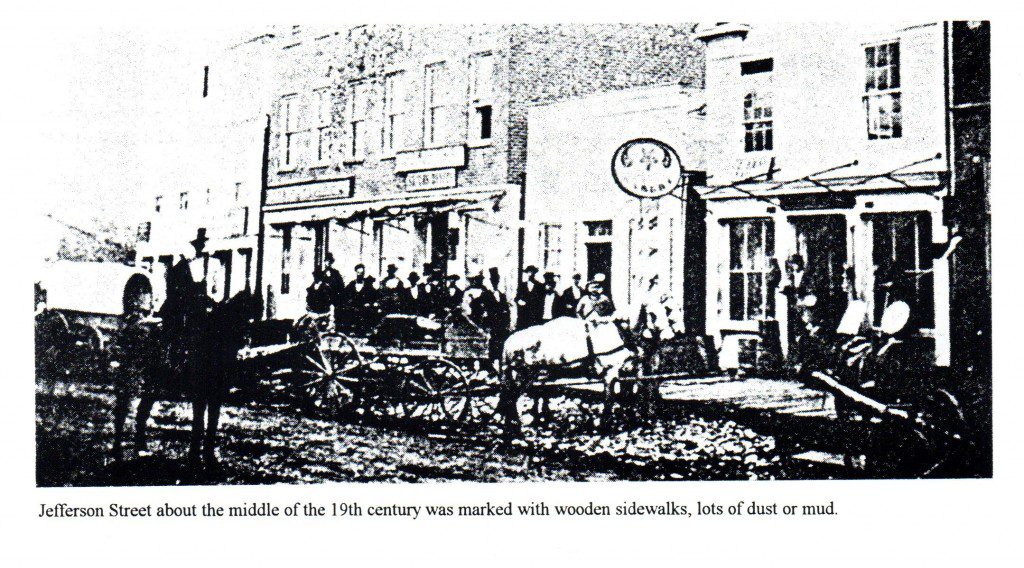
Traffic on the canal increased and the town of Huntington grew. However, when the newly built Wabash Railroad reached Huntington on New Year’s Day in 1856, canal business received a direct blow and the canal finally closed in 1874.
Lagro, dependent on canal traffic, lost population as people moved on to work for the railroad. The mother church of the area, St. Patrick’s, became just a mission of Huntington.
The coming of the railroad also had a great effect on the settlement of Antioch (Andrews) west of Huntington when railroad officials established a division point there between Fort Wayne and Lafayette. Included were switching yards, a round-house and engine shops. Large numbers of workers, many of them Irish, flocked to the little town for jobs. A Catholic church was established there in 1888 as a mission served by Huntington. In just a few years the railyards and many workers moved on to Peru. The mission church was abandoned.
With work scarce in Lagro and then in Antioch, many Irish families moved to the larger town of Huntington in search of jobs. Here they became members of SS. Peter & Paul parish.
Timeline of events during this period: 1675 – French Jesuits first visit Miami Indians. 1763 – Area comes under British rule. 1778 – George R. Clark captures British posts of area for Virginia colony. 1787 – As part of new Northwest Territory, Indiana area comes under U.S. rule; 1800 – Wm. H. Harrison first territorial governor. 1816 – Indiana becomes a state. 1832 – Local work begins on Wabash & Erie Canal. 1834 – County of Huntington organized; first of three treaties signed to cede Miami territory to the white man. 1846 – Miami Indians forced to move to Kansas territory. 1848 – Town of Huntington incorporated. 1856 – Wabash Railroad reaches Huntington. 1858 – Blessed Virgin appears to Bernadette at Lourdes. 1861 – Indiana supports Union in Civil war but has many Confederate sympathizers. 1880 – Bingo developed from Italian game Tombola.
John Roche – 1817-1894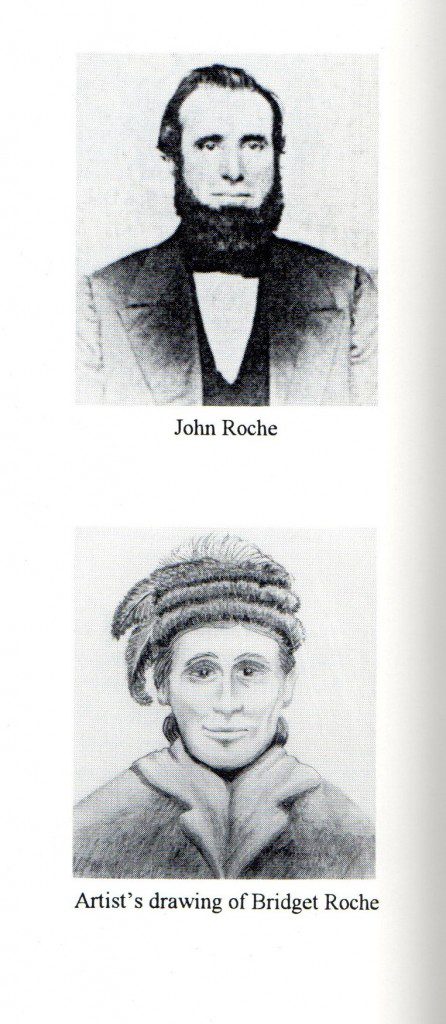
John Roche was the oldest in the family of Martin Roche, who came here from Ireland in 1834. The father died just a few months after their arrival. To support the family, 17 year old John went to work as a laborer on the Wabash and Erie Canal then being built in the area. Within a relatively short time he became an engineer, then superintendent of repairs.
At age 26 he was appointed County surveyor and also treasurer for a short term. Chief Francis LaFontaine employed him as his private secretary for tribal affairs and also to manage his store at the forks of the Wabash. At age 28, Roche became the business partner of Francis LaFontaine and the store was moved into Huntington.
At the death of Chief LaFontaine in 1847 the partnership ended but Roche continued the business until 1859. Roche was named executor of LaFonaine’s will and was responsible also for the care and education of the seven LaFontaine children.
Roche was president of the first financial institution in Huntington and figured prominently in persuading the Wabash Railroad to run its line through Huntington rather than Liberty Mills.
Later John Roche turned to farming and speculation in real estate. He eventually owned 10,000 acres of farm land, including much of the swamp land around Markle which he developed into usable area for crops. When he died in 1894 he was the most extensive property owner in the County. His name is on many of the abstracts of local home owners.
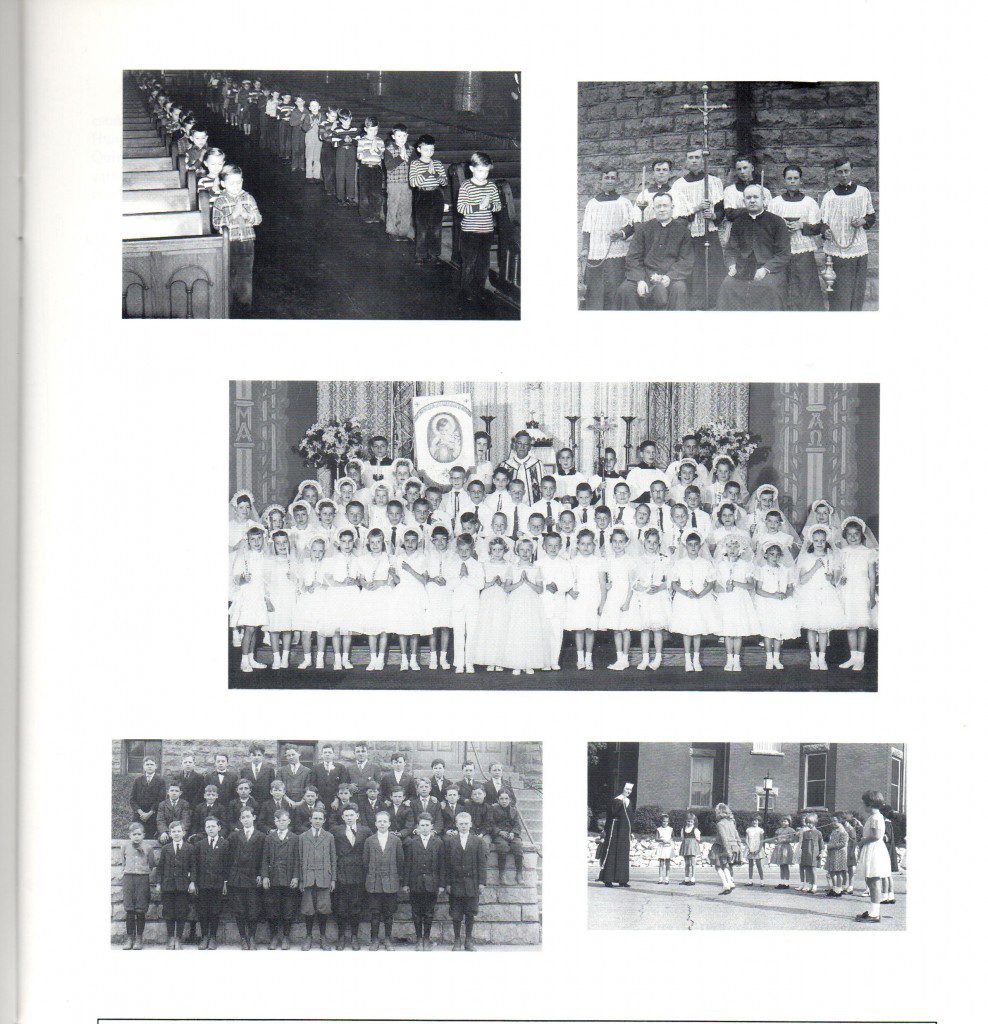
The Beginnings 1896-1910
The parish of SS. Peter & Paul had been established as a church for the Germans of the area, had German pastors, used that language in sermons, announcements, etc. Language differences caused a rift in the congregation. As the number of non-German members increased there was pressure for change. For years one parishioner, prominent businessman John Roche, had been advocating a second Catholic church in Huntington for the English-speaking people. Originally he diplomatically based his argument on the need for a church across the river because of seasonal flooding. He died in 1894, before he could accomplish his goal.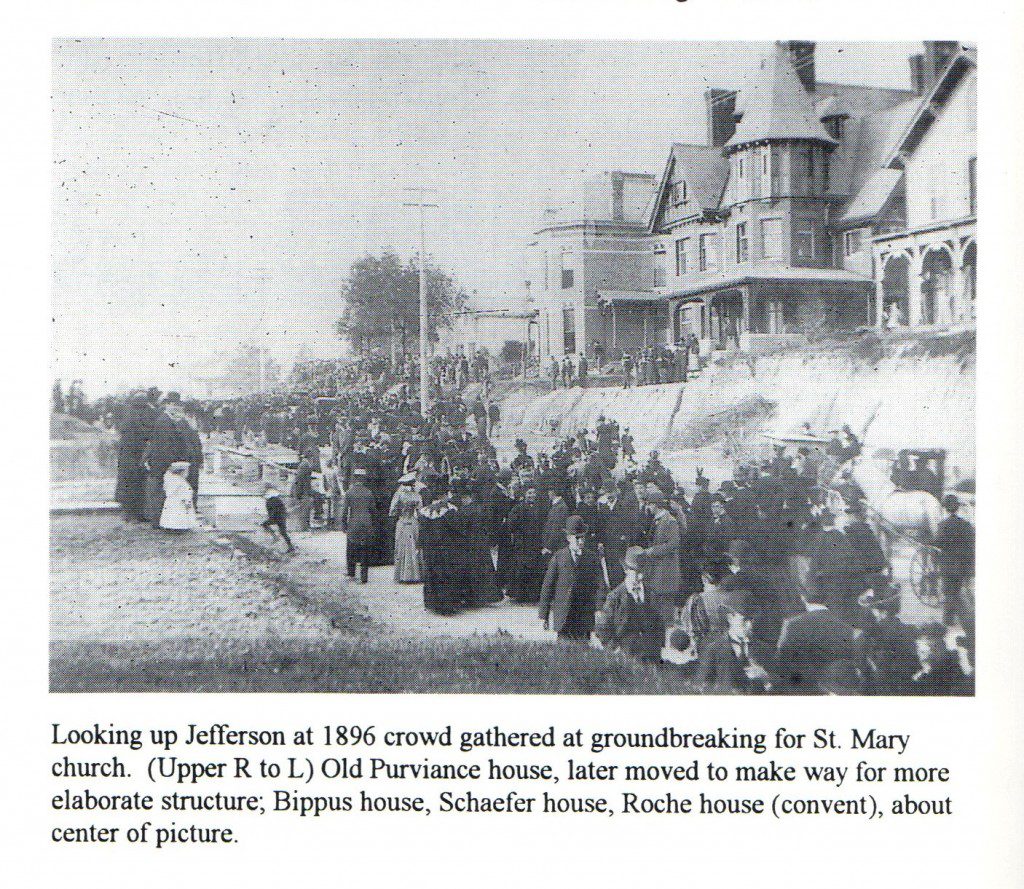
His sister, Bridget, inherited most of his vast estate. She decided to use part of it to make his dream come true and contacted Bishop Rademacher on the matter. He approved the idea if a suitable site could be found. She bought the property next to the Roche home. It was believed to be the spot on which the first Catholic Mass had been celebrated in the area about 1834.
On May 16, 1896 Bishop Rademacher granted the establishment of St. Mary parish in Huntington and named Father John R. Quinlan, assistant pastor at the cathedral, to be the pastor of the new church.
Chicago architect M. A. Druiding was hired to draw the plans. His Roman basilica style was approved. Work began immediately and the cornerstone was laid on Saturday, October 3, 1896, on what would have been John Roche’s 79th birthday.
Bishop Rademacher officiated at the ceremonies and welcomed the new parish into the diocese. Father Andrew Morrissey, C.S.C., president of Notre Dame University, gave the dedication address.
More than 10,000 were at the event, with 5,000 of them from other cities. There were two trains from Fort Wayne plus another with 10 coaches for people from Peru, Wabash and Lagro; 34 marching units; five bands.
The building was a very impressive one for the little town of Huntington. It was of red, polished brick – 68 1/2 feet wide, 147 feet long with towers of 130 and 94 feet.
Inside, the ceiling was 57 feet high. Eight large columns of imported Italian granite supported the arches in the nave. The C. R. Noel firm of Chicago was hired to do the painting. Above the main altar was a small mural of the Assumption. The Flight into Egypt and the Annunciation were depicted above front arches in the nave.
The altars were of wood and painted white. They were very ornate with statues of angels and favorite saints in small niches as well as the large statues usually seen. The Stations of the Cross were from France. Pews, confessional and all wood trim was of oak. Stained glass windows in the sanctuary depicted the four Evangelists; other windows had geometric designs in pastel colors.
A movable pulpit with a shell-like sounding board above it was kept at the left front of the nave and pushed on tracks to the center aisle at sermon time. Heat was provided by steam boilers; illumination by gas light.
Cost of the church building was over $75,000 in 1897 ($1.5 M in 1996 dollars).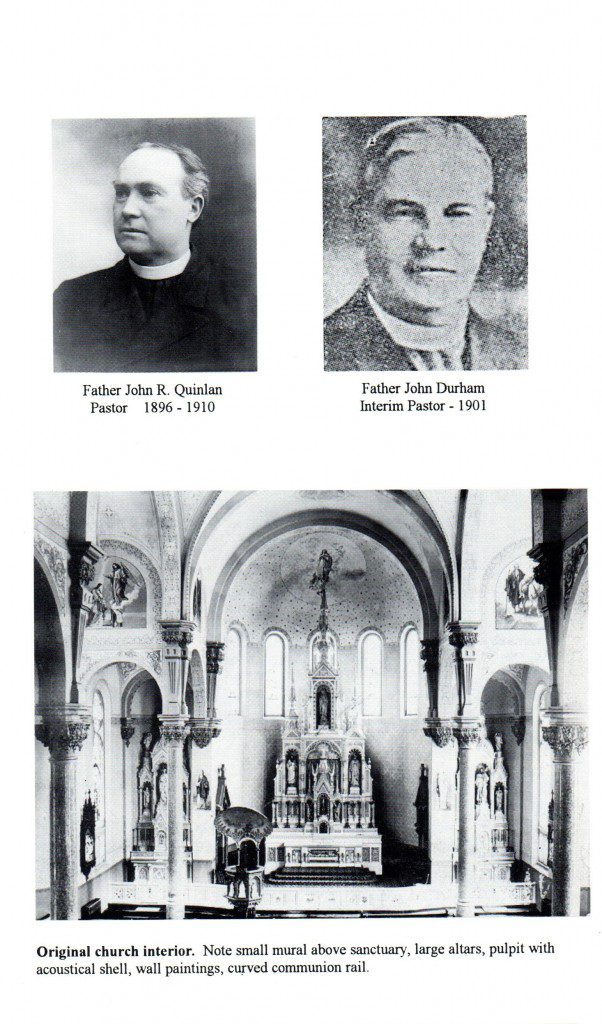
Bishop Rademacher dedicated the building on October 10, 1897 at a solemn pontifical Mass with Father Joseph Delaney of Fort Wayne preaching the sermon.
The welcoming committee that day consisted of Dan Broderick, Mike Keefe, Tom Claybaugh, James Moran, John McGahan, Pat McCarty, George Boyle, Ed Burke, Frank Ehinger, Luke O’Brien, Bryan O’Connor, James McMullen, Charles Fusselman, and Thomas Brady.
In 1897 there were 83 families in the new parish; 130 children in the school.
Bridget Roche paid for the church and its furnishings, including an organ. Members of the new parish raised the money to build a rectory next to the church, a four-room school on Warren Street and a heat plant for the entire complex. Cost for all these additions amounted to just under $23,000 (about $500,000 in 1996). It was all paid off except $3,350 ($72,000 in 1996).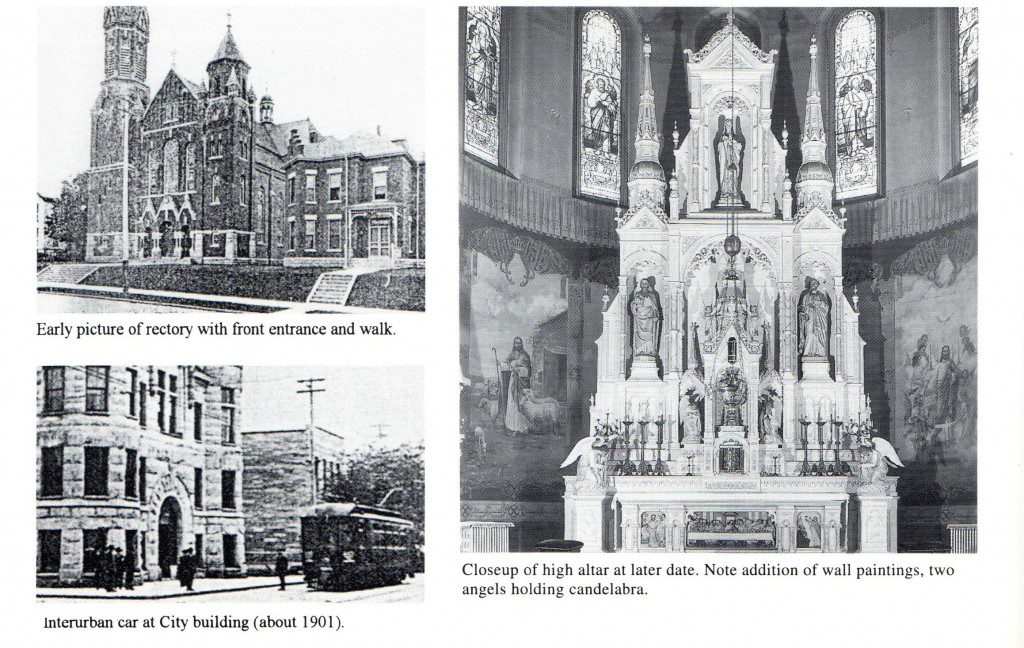
Father Quinlan guided the building program but commuted from the cathedral until the new rectory was completed.
St. Mary School opened a month before the church was dedicated. From September until the spring of 1898 when the new school was finished, students were housed in Roche Hall at the corner of Jefferson and Matilda (Park Drive) Streets. The school was staffed by five Sisters of Providence from St.-Mary-of-the-Woods, Indiana. High school courses were offered also until 1910 when a commercial course was substituted.
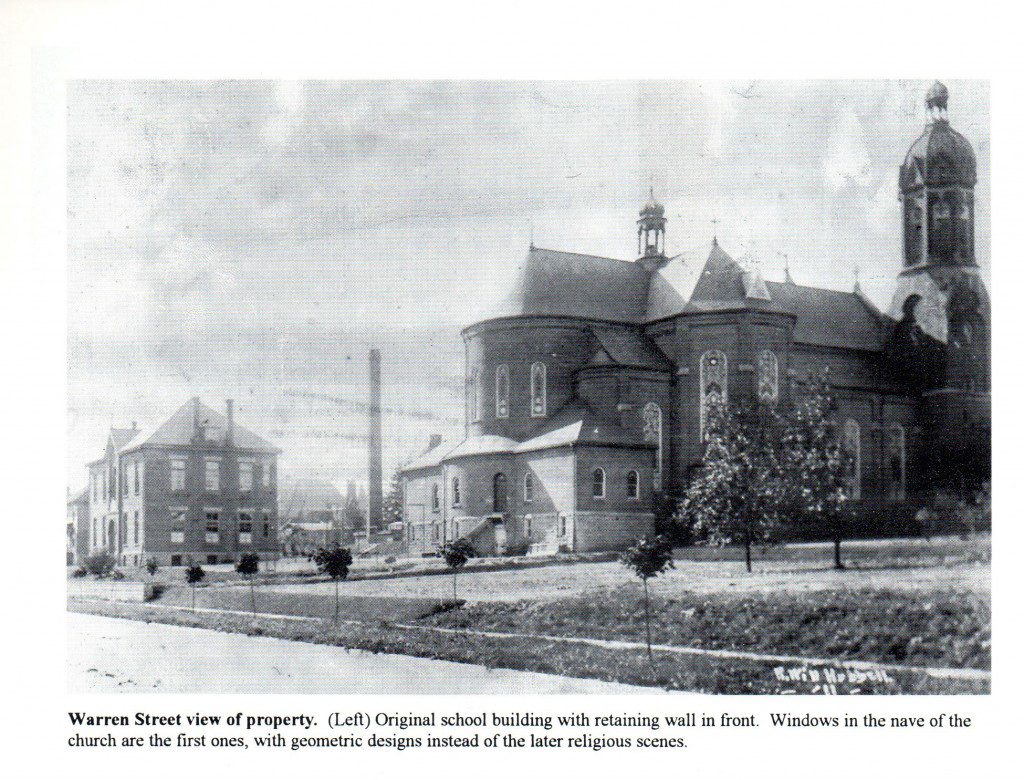
Parish records list the first baptisms: John Bernardos Moran and John Ralph Reddings on Oct. 3, 1897, the day of the dedication. The First Communion class on June 12, 1898 consisted of 15 boys and 15 girls. The same group made up the first Confirmation class on October 9, 1898. Bridget Roche and Timothy Collins acted as sponsors for the entire class.
The first marriage was that of Francis Diamond and Agnes Beck on October 10, 1897. The first death recorded was of Catherine Belten, age 79, December 1, 1897.
The first organizations in the new parish included the Living Rosary Society for women of the parish, the Young Ladies’ Sodality, Young Men’s Sodality, Married Men’s Sodality, Boys’ and Girls’ Society, Conference of St. Vincent de Paul.
Women of the new parish took on the job of furnishing the rectory and organized a choir of mixed voices.
In March, 1901 Father Qunlan was named rector of the Cathedral in Fort Wayne. Father John Durham became pastor of St. Mary but the change lasted only a few months. Father Quinlan’s health began to suffer in his new assignment. He was allowed to return to St. Mary as pastor and remained until 1910.
When the local council of the Knights of Columbus was organized in 1904, Father Quinlan was named as its first chaplain.
In 1908 the parish received its first assistant pastor, Father Voelman, but he served only during the summer.
Bridget Roche died in 1909 and left her home to the parish to be used as a convent for the Sisters who taught here. She also left 25 parcels of land to the Diocese to be used as needed for St. Mary Church and school. Most were lots within the city limits but there were also two quarter sections listed.
Timeline of events during this period: 1896 – Klondike gold rush started. 1897 – Sousa wrote “Stars & Stripes Forever”. 1898 – Spanish-American War. 1900 – Cake Walk most popular dance. 1901 – Marconi sends first transatlantic radio message. 1902 – Beatrix Potter publishes Peter Rabbit stories. 1902 – Wright brothers fly a powered plane; First World Series of baseball. 1904 – Steerage rate Europe to U.S. is $10. 1905 – Albert Einstein formulates Theory of Relativity. 1906 – San Francisco earthquake kills 500; Pure Food & Drug Act adopted. 1907 – Boy Scouts founded. 1908 – Model T Ford appears.
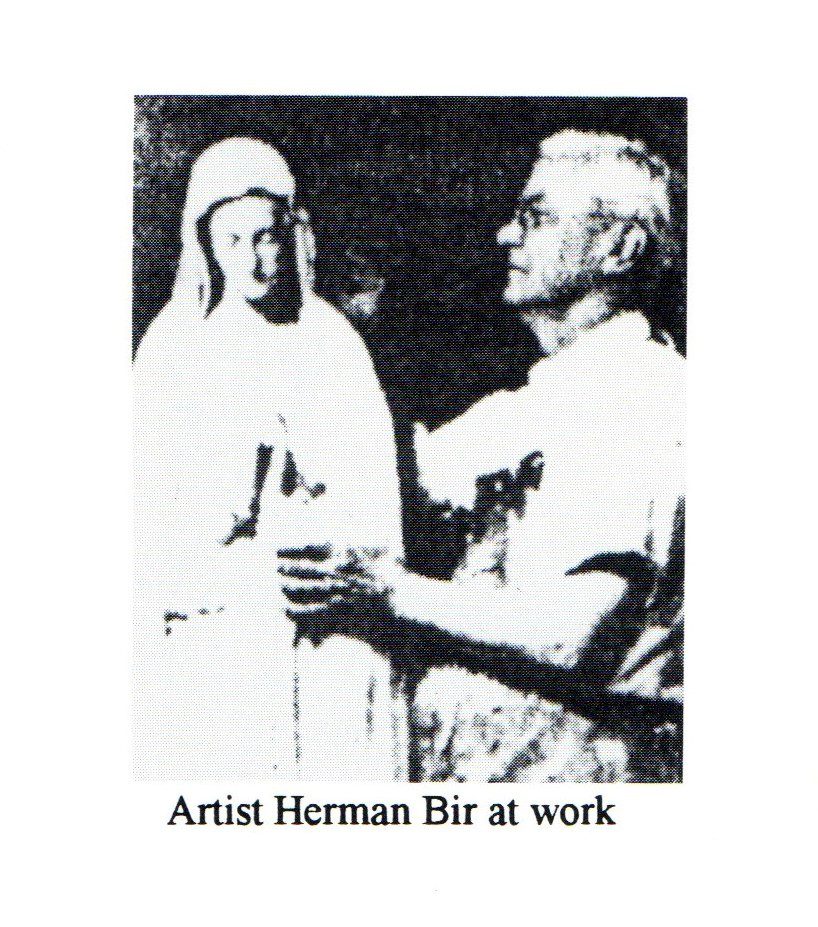 The Teen Years
The Teen Years
When Father John Noll became pastor in 1910, he was already known locally as editor of The Parish Monthlymagazine. During his 15 years at St. Mary he channeled his great energy to growth of both the parish and the printed word. He launched a national Catholic weekly, Our Sunday Visitor, to counter misinformation about Catholicism. First issue in 1912 had a total of 35,000 copies. Circulation grew rapidly to half a million and then hit the million mark in 1961. The plant also printed and distributed books, pamphlets and magazines. Through the years it has employed hundreds of local people including many from St. Mary’s.
But the editor was also a very active pastor. He organized the men into a thriving Holy Name Society; the women’s group was strengthened by joining the national Confrternity of the Holy Rosary and has survived as the most active of all parish groups.
In 1910, the altar boys raised money to have electric lights installed in the church, including a band of bulbs with glass shades about seven feet up on each pillar. The high altar was lighted for the first time in 1911. The original Van Dinter organ was upgraded and electrified. Stained glass windows were imported from Bavaria, with most windows in the nave of the church depicting some event in the life of the Blessed Mother.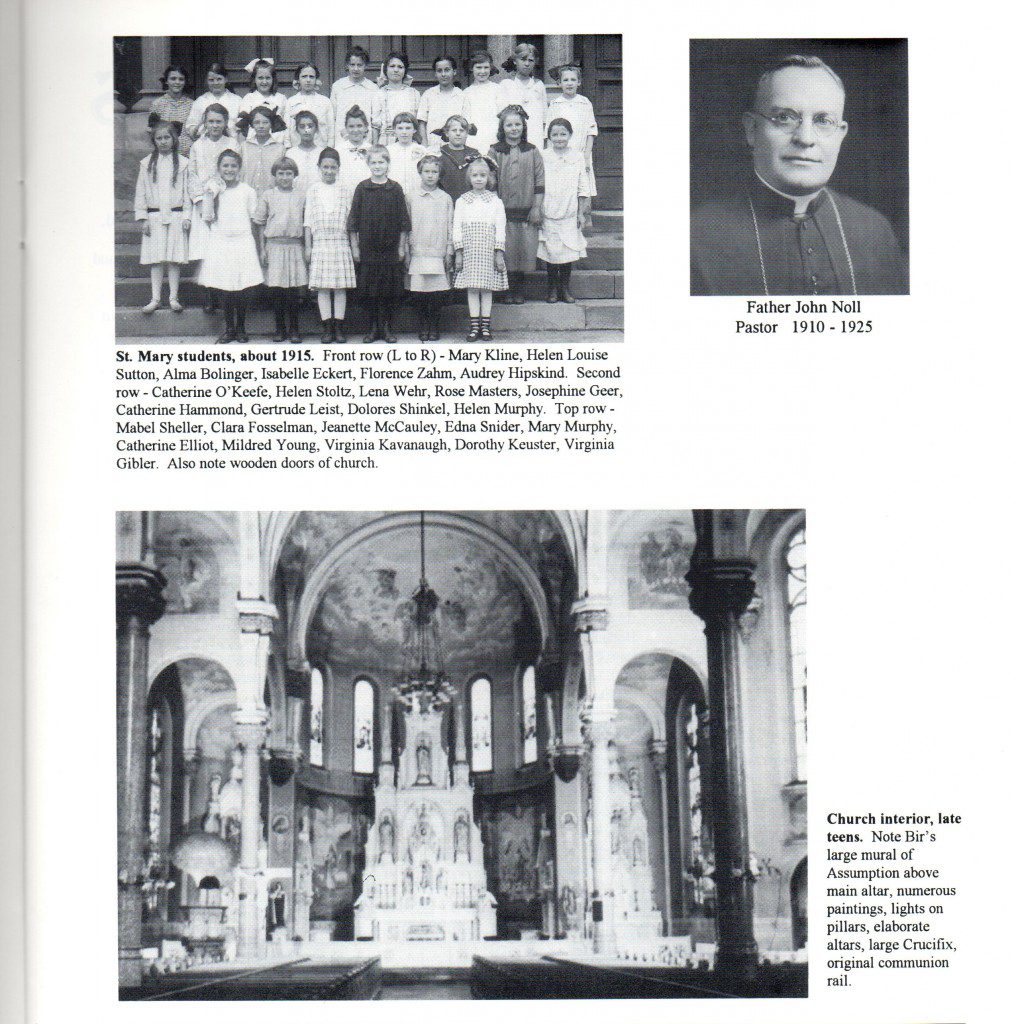
Father Noll was very active in civic affairs, a charter member of the local Rotary Club and enthusiastic supporter of the Chamber of Commerce. These local ties were helpful when an engineering mistake in the new boiler provided only about half the amount of heat needed for the church. He persuaded the City Fathers to include the church building in the public steam heat system used for the public buildings and some of the private homes.
In 1916, the pastor-editor successfully used the parish for an experiment in church support that he then introduced nationwide. He had read about the Churches of Christ distributing packets of envelopes to encourage support of their missions. He thought the idea could be adapted for general parish support and would be better received than the controversial pew rent system then in effect. The experiment also led to the addition of an envelope printing department at OSV. It became the largest distributor of collection envelopes to churches of all denominations.
Timeline of events during this period: 1910 – Halley’s comet observed. 1912 – Titanic sinks, 1,573 drown; Mary Pickford called “America’s Sweetheart”. 1913 – 16th Amendment establishes annual income tax; Fox-trot comes into popularity. 1914 – World War I starts in Europe. 1916 – Poncho Villa, Mexican revolutionary, raids New Mexico. 1917 – Mata Hari executed as spy; U.S. declares war on Germany. 1918 – Daylight saving time starts in U.S. Worldwide, 22 million die in flu epidemic, 500,000 in U.S.. 1919 – Jack Dempsey, was heavyweight champion; American Legion formed.
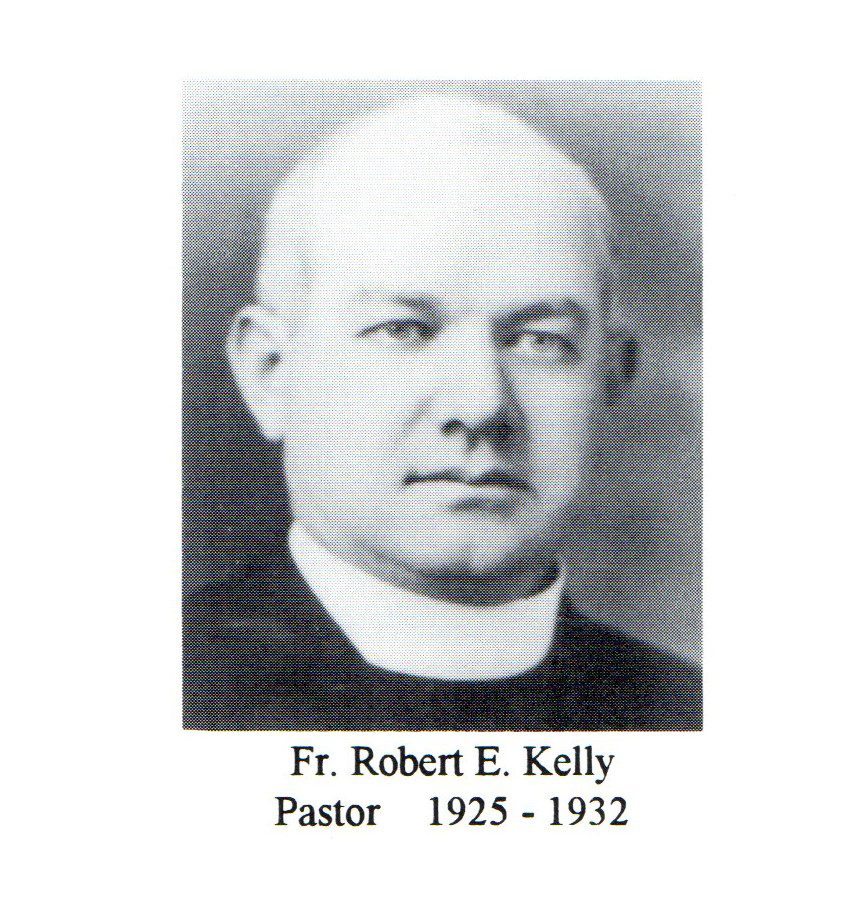 The Twenties
The Twenties
The parish continued to grow in membership. It was evident that the original four-room school was inadequate in size and facilities to take care of present and future enrollment. A high school education was becoming standard; a formal athletic program was included in most schools now.
It was decided to double the size of the school, add a gymnasium and a basement chapel. Cost was $70,000. Money realized from the Roche estate paid for the construction. The new addition opened in October, 1921 and was debt free.
Through the efforts of Father Kelly, assistant pastor, the two-year commercial course for girls was dropped and a co-ed high school started with first and second year classes at the beginning, growing to the full four-year course. St. Mary High School graduated its first class in 1924.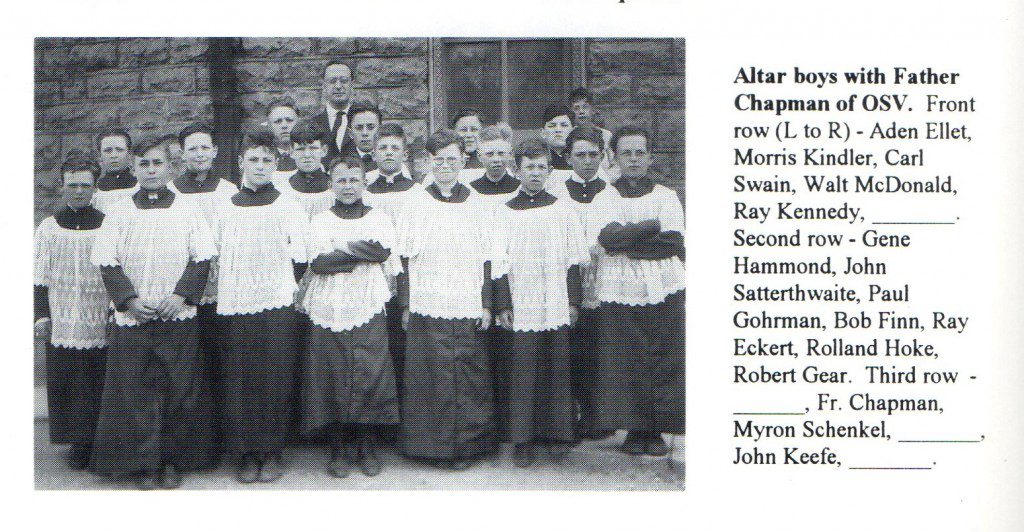
This move brought a big change in faculty. The Sisters of Providence who staffed the school since its inception in 1897, were not allowed, at that time, to teach teenage boys. The Sisters of St. Francis of Perpetual Adoration took over the teaching duties and continued to teach here, celebrating their 75th anniversary in Huntington on September 12, 1996.
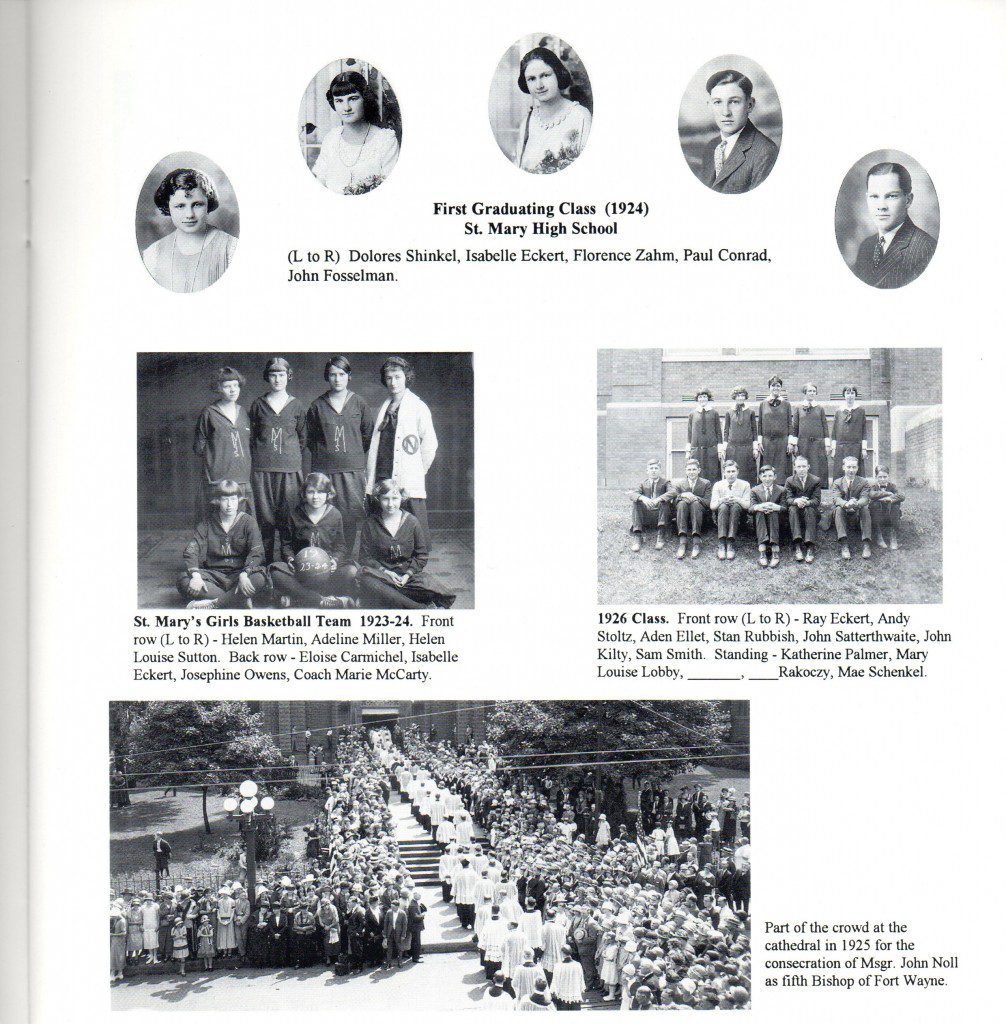
It was also in the Twenties that Msgr. Noll sponsored the building of the Sisters of Our Lady of Victory and brought those catechists to the area. He also encouraged the establishment of St. Felix Friary at the west side of the city as a novitiate for the Capuchin Fathers.
After the death of Bishop Alerding in late 1924, Msgr. Noll was named Bishop of the Diocese. (In tribute to the great work he had done for the Church nationally, he was given the title of Archbishop “ad personam” in 1953).
Assistant pastor Father Robert Kelly was named to lead the parish as its new pastor.
Timeline of events during this period: 1920 – Women get vote under 19th amendment; Joan of Arc canonized. 1921 – Unknown Soldier interned at Arlington; Indiana is center of KKK violence. 1922 – Insulin first administered to diabetics. 1924 – J. Edgar Hoover heads FBI; “Four Horsemen” are stars of N.D. – Army game. 1925 – Scopes trial in Tennessee on Evolution. 1927 – Charles Lindbergh flies the Atlantic; Iron lung developed for polio victims. 1928 – Color motion pictures come into being. 1929 – Lateran Treaty establishes independent Vatican City State; Collapse of N.Y. Stock Exchange brings world crisis.
The Thirties
Assistant pastor, Father Dillon, was named Diocesan Superintendent of Schools in 1930. At about the same time he had to assume many of the duties of the pastor because of Father Kelly’s poor health. To help out, the Capuchins from St. Felix monastery served as assistants at St. Mary from 1931 to 1941.
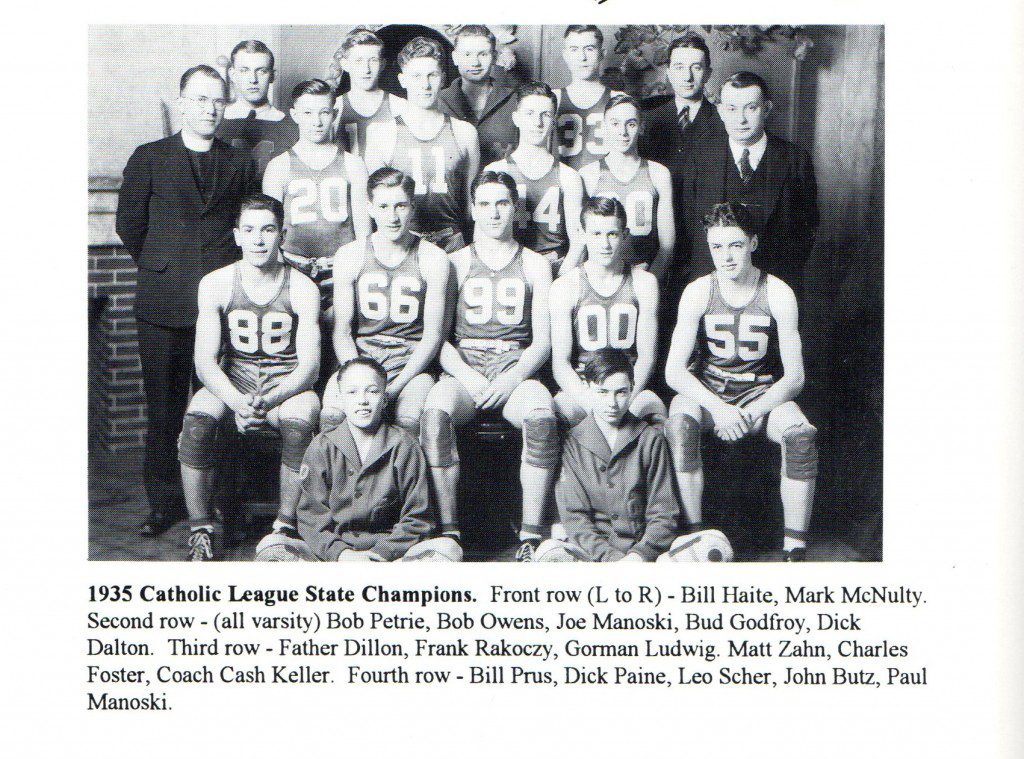
When Father Kelly died in 1932, Bishop Noll named Father Dillon to take over officially as pastor.
School news made the biggest parish headlines in 1935 and 1936. St. Mary’s basketball team became became State champs of the Indiana Catholic League in ’35. They were feted by city officials, local clubs and went on to Chicago to play in the Nationals. In the semi-finals, they lost to the team that took the title. But the St. Mary’s boys received a lot of publicity because all the other teams in the play-offs were from large schools. St. Mary’s team represented a school of just 40 students, of whom 22 were boys. They were the big favorites of all sports writers and photographers at the meet.
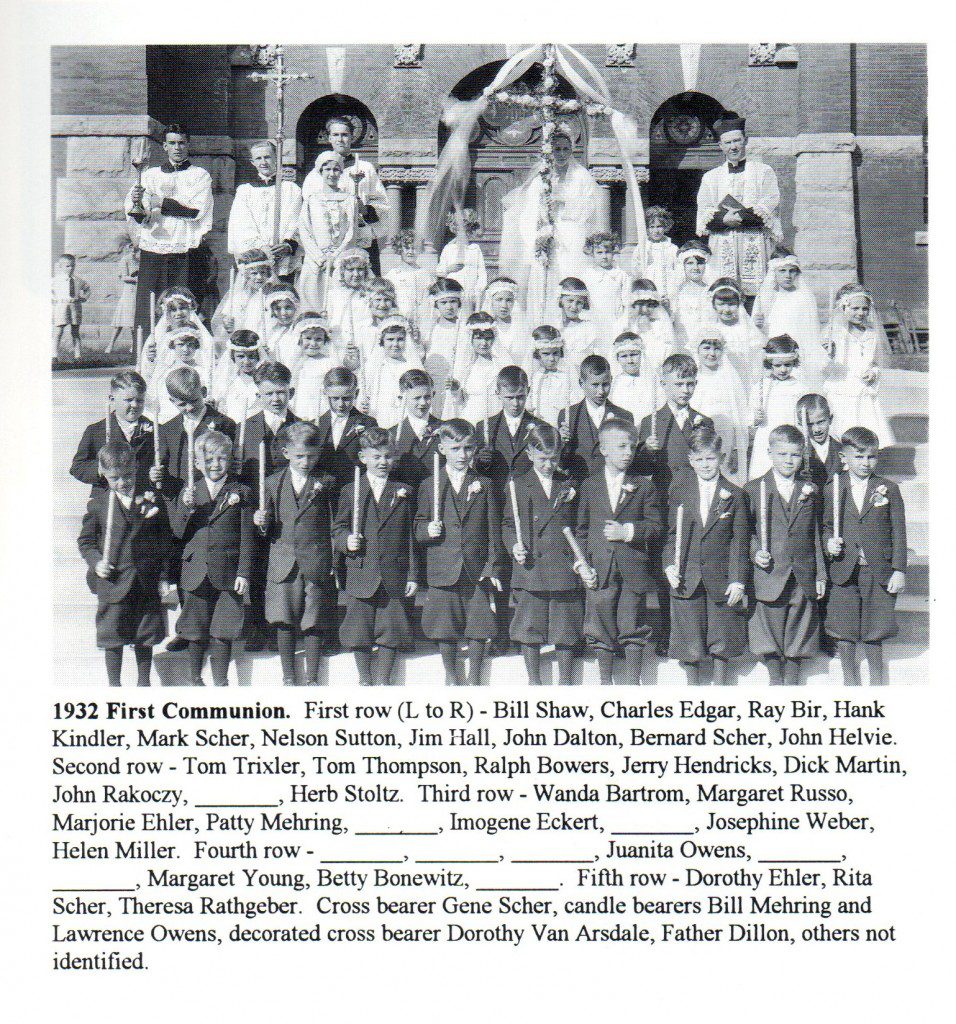
A small foot note that assumed great importance in parish life was the memo in 1935 that Sister 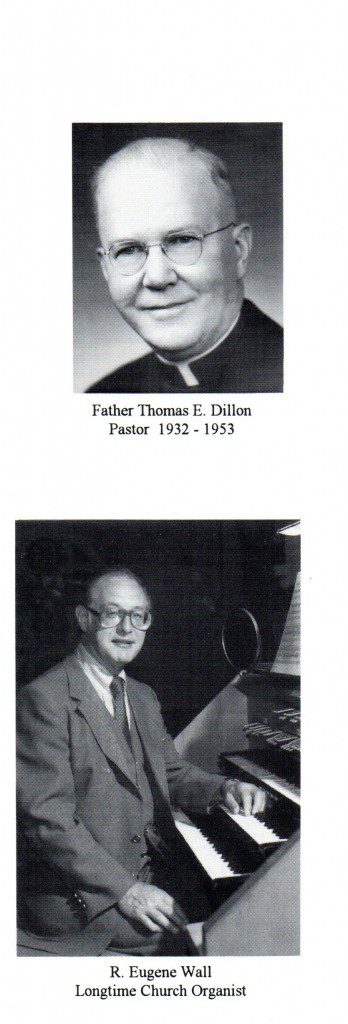 Johannina, organist and high school choir director, was grooming junior class member, Gene Wall, as student organist. It was a move that grew into a 57-year career of service to the parish.
Johannina, organist and high school choir director, was grooming junior class member, Gene Wall, as student organist. It was a move that grew into a 57-year career of service to the parish.
Top news in local Catholic education in 1936 was the formation of Huntington Catholic High School, combining the four-year St. Mary High with the two-year course at SS. Peter & Paul school. The students attended classes in both buildings. Faculty was drawn also from both parishes with a Franciscan and a School Sister of Notre Dame alternating as principal each two years. Enrollment was 108 students that first year. Some HCHS students also attended Huntington High for classes in Home Economics and Manual Arts.
The public steam heat loop that had served the parish for more than 20 years was discontinued city wide. In 1936 a new steam heat plant for the parish was built at the northwest corner of the gym, an area that originally housed a greenhouse and garage.
Timeline of events during this period: 1930 – Congress creates Veterans Administration; Blondie comic strip begins. 1931 – Thomas Edison dies; Knute Rockne dies in plane crash. 1932 – U.S. unemployed 13.7 million. Lindbergh baby kidnapped; 1933 – Bank Holiday to slow economic crisis; Prohibition repealed; Chicago World’s Fair. 1934 – Dionne quintuplets born in Canada; John Dillinger shot. 1935 – Roosevelt signs Social Security Act. 1936 – Edward VIII abdicates British throne; Jesse Owens stars at Berlin Olympics. 1937 – Airship “Hindenburg” burns – first live radio newscast. 1938 – Hitler marches into Austria; Forty hour work week in U.S. 1939 – World War II starts; Baseball begins on TV; Nylon stockings introduced.
The Forties
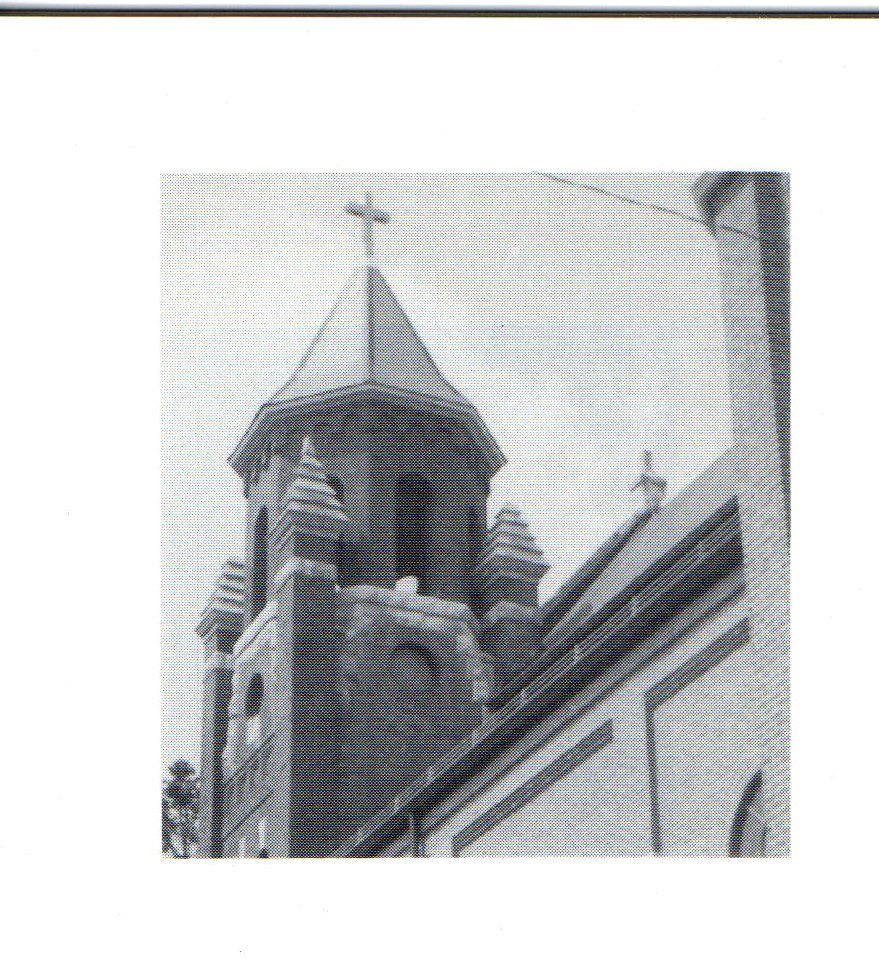 World War II was influencing almost everything in daily life. Younger men were drafted for military service; women took full-time jobs in factories for defense work.
World War II was influencing almost everything in daily life. Younger men were drafted for military service; women took full-time jobs in factories for defense work.
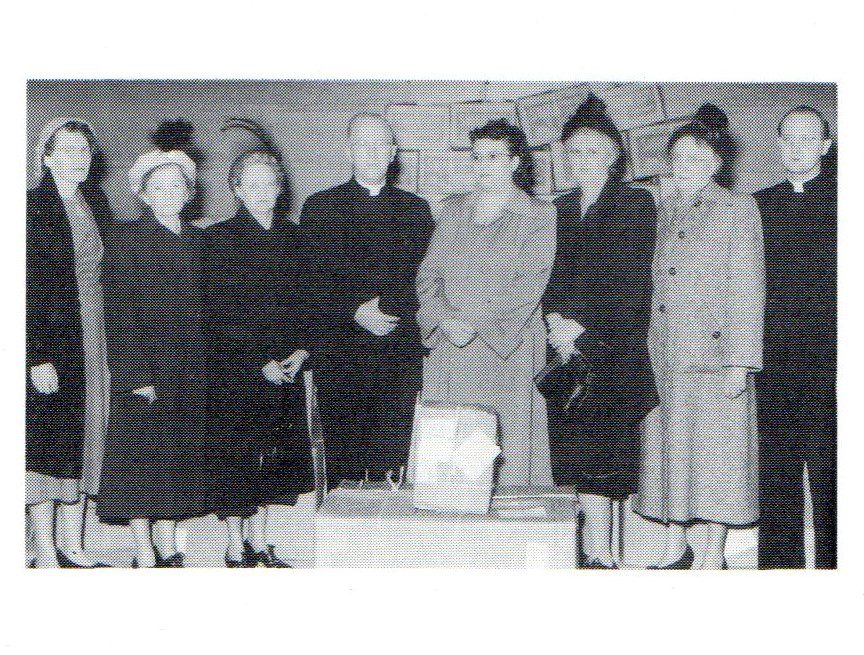
This big change affected parish life. The Depression years of the Thirties had already increased the number of fervently praying and practicing Catholics. The war years continued the trend. St. Mary had 350 families on its roster. Churches were filled for services but other parish activities slowed down. The war effort was taking up much of what had been leisure time. Food and gasoline rationing interfered with social life, especially for adults. (Children and young people still walked to school and other activities.)
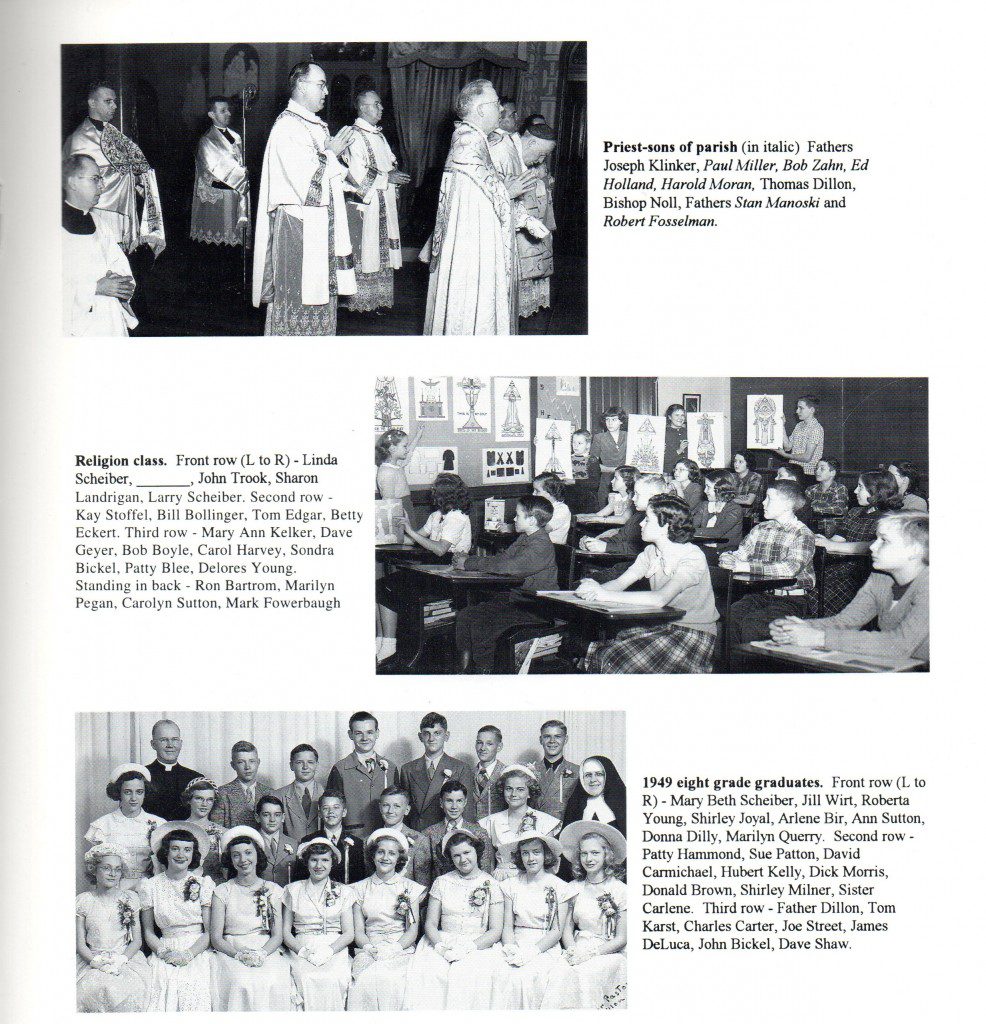
Father Dillon associated the teenagers of the parish with the Catholic Youth Organization which emphasized group activities at parish and inter-parish and (less frequently) diocesan levels. Retreats, picnics, dances, homegrown sports events kept the young people in touch with their Catholic peers and were very popular.
Meantime the diocese affiliated with the National Council of Catholic Women. The ladies of the parish joined national projects to give aid and comfort to service men and women, care for overseas children orphaned by the war, send food parcels to countries overrun by the fighting.
In 1944, the Fort Wayne Diocese lost some territory when the Lafayette Diocese was created from the sourthern portion of the area. Priests serving in the area at the time remained at their posts and were counted as members of the new diocese.
In the late Forties preparation was made for the 50th anniversary of the parish. The entire church was repainted inside. Murals on the side walls of the sanctuary and on the arches above the side altars were painted out. The ornate altars were replaced by simple modern ones; lighting in the church was changed also to modern style fixtures. These changes brought controversy. However, the new cushioned kneelers and floor tile were very welcome.
As a memorial to Father Kelly, a storage area at the southwest corner of the church vestibule was converted into a new baptisry.
Timeline of events during this period: 1940 – Churchill becomes Prime Minister; Films: Grapes of Wrath, Fantasia, Great Dictator. 1941 – Japan bombs Pearl Harbor; U.S. enters World War II; Lou Gehrig dies. 1942 – Rationing begins in U.S.; Songs: “White Christmas,” “Paper Doll,” “Old Black Magic”. 1943 – Teheran Conference of Roosevelt, Churchill, Stalin; Zoot suits & jitterbugging. 1944 – D-Day, June 6; cost of living up 30%. 1945 – 35 million dead in WWII. 1946 – Churchill “Iron Curtain” speech; Francis Xavier Cabrini canonized; “Baby & Child Care” – Benj. Spock, M.D. 1948 – Gandhi assassinated; Berlin airlift begins. 1949 – Vietnam divided into North & South.
The Fifties
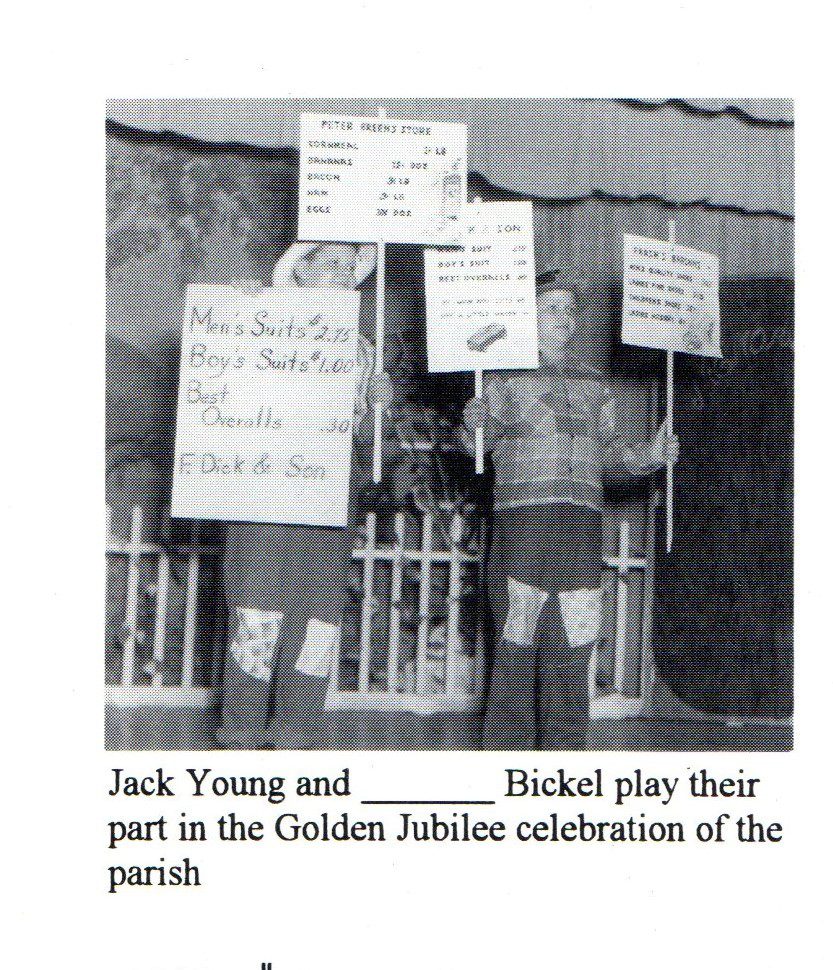 In the early Fifties it was the recory’s turn to get some attention. In addition to much needed painting and redecorating, the back porch was enclosed to become a new office; the front entrance facing Jefferson Street was closed off, making a side door the major entrance.
In the early Fifties it was the recory’s turn to get some attention. In addition to much needed painting and redecorating, the back porch was enclosed to become a new office; the front entrance facing Jefferson Street was closed off, making a side door the major entrance.
Father Dillon died in 1953. Father Edward Miller became pastor.
Expansion was in the air. An increase in school enrollment and projection of future enrollment led to the addition of a new building area in the space formery used as a playground. The entire school was modernized at a cost of $280,000 with a goal to house 500 students.
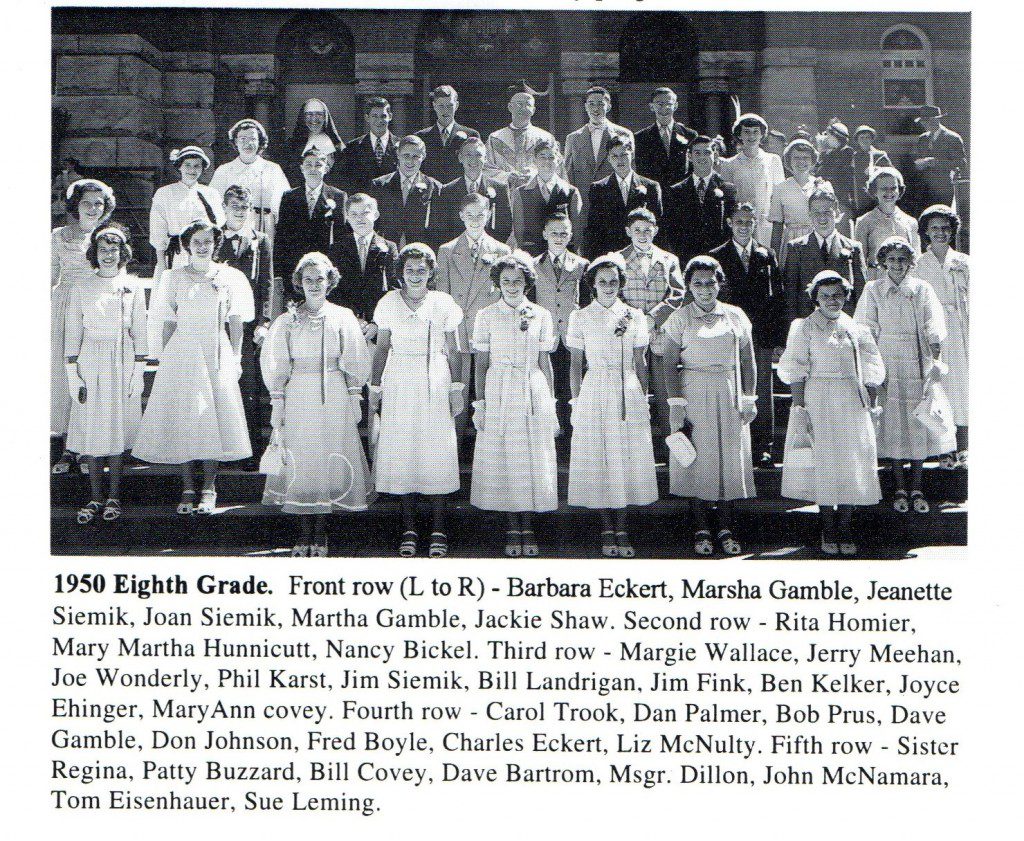
About the same time the parking lot was expanded by buying the former home of Dr. Schaeffer just south of the rectory. And a two-car garage was attached to the rectory.

Bishop Noll died in the summer of 1956; Auxiliary Bishop Leo Pursley was named to head the diocese. That same year the diocese again lost some of its territory with the creation of the Gary Diocese in the northwestern part of the state. Again, priests stationed in the new diocese remained there.
On Sundays between Masses, the Sisters taught catechism to grade school children who attended public schools. The classes were sponsored by the Confraternity of Christian Doctrine. Late in the Fifties, CCD classes were started for public high school students. They were held on a weekday evening and were taught by lay people.
Timeline of events during this period: 1950 – Sen. McCarthy starts Unamerican Activities trials; Assumption declared church dogma. 1951 – Color TV produced. 1953 – Elizabeth II crowned Queen of England; Lung cancer linked to cigarette smoking. 1954 – School segregation illegal; Salk’s anti-Polio serum introduced. 1955 – AFL & CIO merge under Meany; Blacks boycott Montgomery bus lines. 1956 – Castro lands in Cuba; Cardinal Mindszenty released from house arrest; TV remote control invented. 1957 – USSR launches Sputnik I & II. 1958 – NASA established. 1959 – Hawaii becomes 50th state.
The Sixties
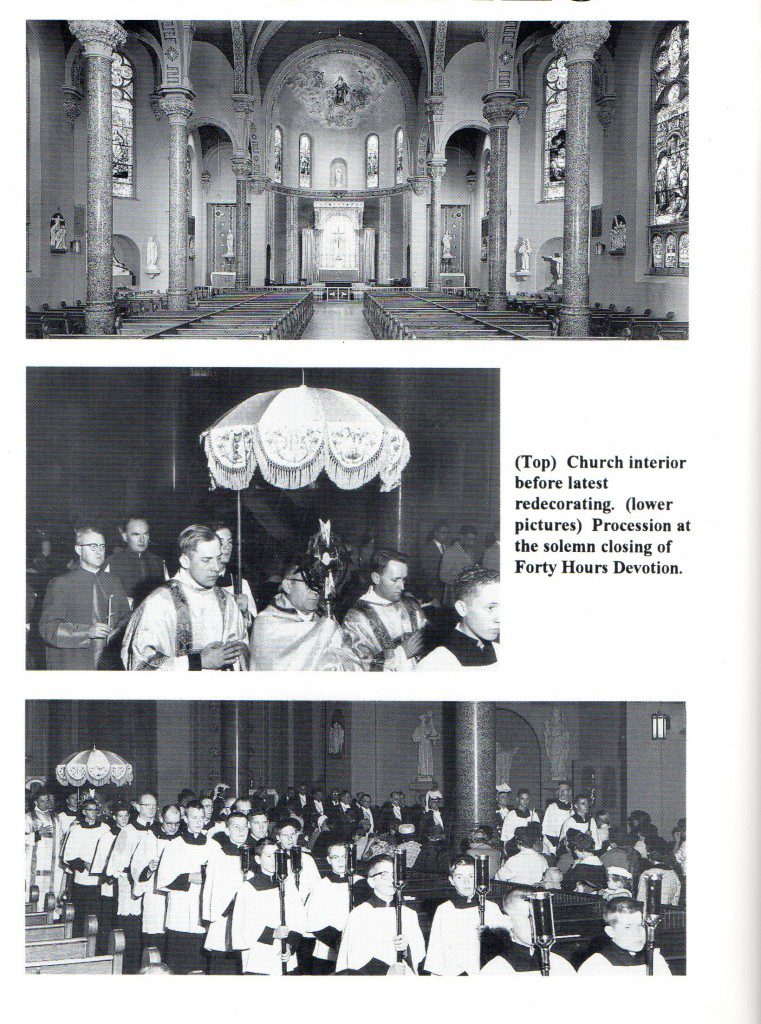
The name of the diocese was officially changed in 1960 to the Diocese of Fort Wayne-South Bend. St. Matthew Church in South Bend was named a co-cathedral.
Pope John XXIII convened the Second Vatican Council in Rome in 1962, bringing together 2,860 bishops to discuss renewal and reform in the Church. Many changes were made affecting local parish life.
In 1964 Mass was celebrated in English for the first time at St. Mary’s; the old Latin Mass was discontinued.
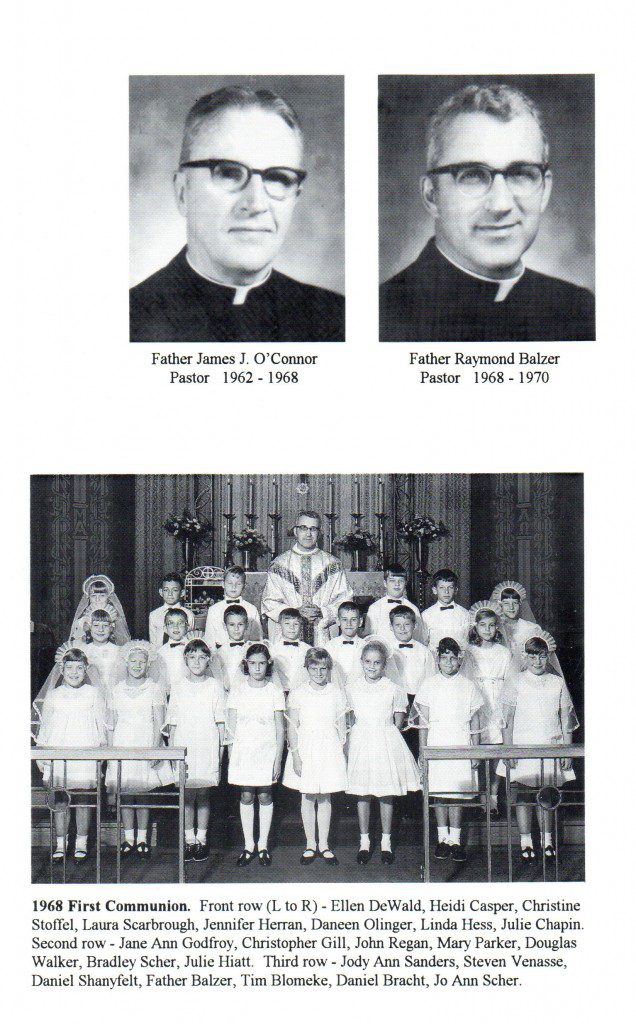
Laws of fasting before Communion were changed for the laity. Instead of the mandatory fasting from midnight, communicants were required to abstain from all food and liquids (except water) for just one hour before Communion.
Beginning in 1966 Catholics could choose to eat meat on Friday (except during Lent) but were expected to substitute another penance for the abstinence. Seasonal ember days (Rogation Days) were discontinued.
At the Pope’s request all churches had a weekly Holy Hour. At St. Mary it was on Thursday nights and averaged attendance of 200 persons each week.
For persons interested in learning more about the Catholic faith, inquiry classes were started in both parishes. This was the introduction of what would become the Rite of Christian Initiation for Adults (RCIA) that culminates with their reception into the Church at the Easter Vigil.
Timeline of events during this period: 1961 – Alan Shepard makes first U.S. space flight; Peace Corps started; Berlin Wall Constructed. 1962 – Second Vatican Council opens; Thalidomide causes malformations in infants. 1963 – President Kennedy assassinated; Dr. DeBakey uses artificial heart during surgery. 1964 – Poll tax abolished in U.S.; Arafat heads Arab guerrillas. 1965 – Medicare enacted; Palm Sunday tornadoes in Indiana; Deaths: Churchill, Ed. R. Murrow, Nat “King” Cole. 1966 – Friday abstinence lifted; U.S. spacecraft lands on moon. 1968 – Martin Luther King and Sen. Robert Kennedy assassinated; “Humanae Vitae” ency. condemns artificial birth control and abortion. 1969 – Neil Armstrong steps out on the moon; DDT insecticide banned.
The Seventies
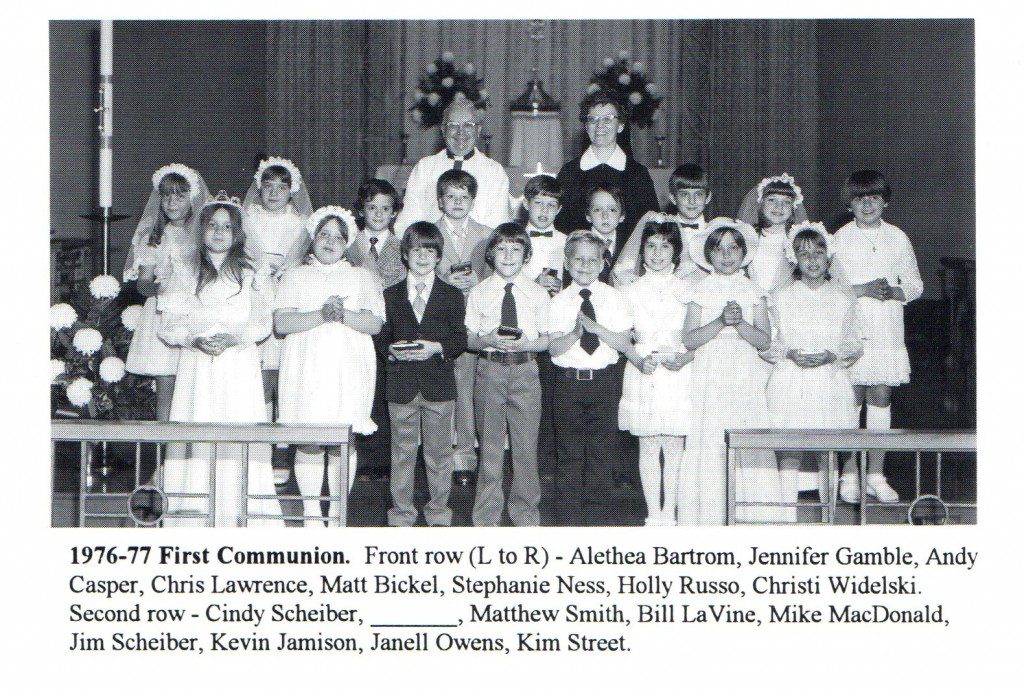
In line with the changes of Vatican II, the parish added a Saturday evening Mass to its Sunday schedule. Early in the decade new Mass prayers and a new Sacramentary were introduced. In 1974, a few members of the laity were trained to be Eucharistic Ministers, giving additional help during Mass and also visiting the ill and hospitalized of the parish.
Receiving Communion under the forms of both bread and wine was also allowed for the laity.
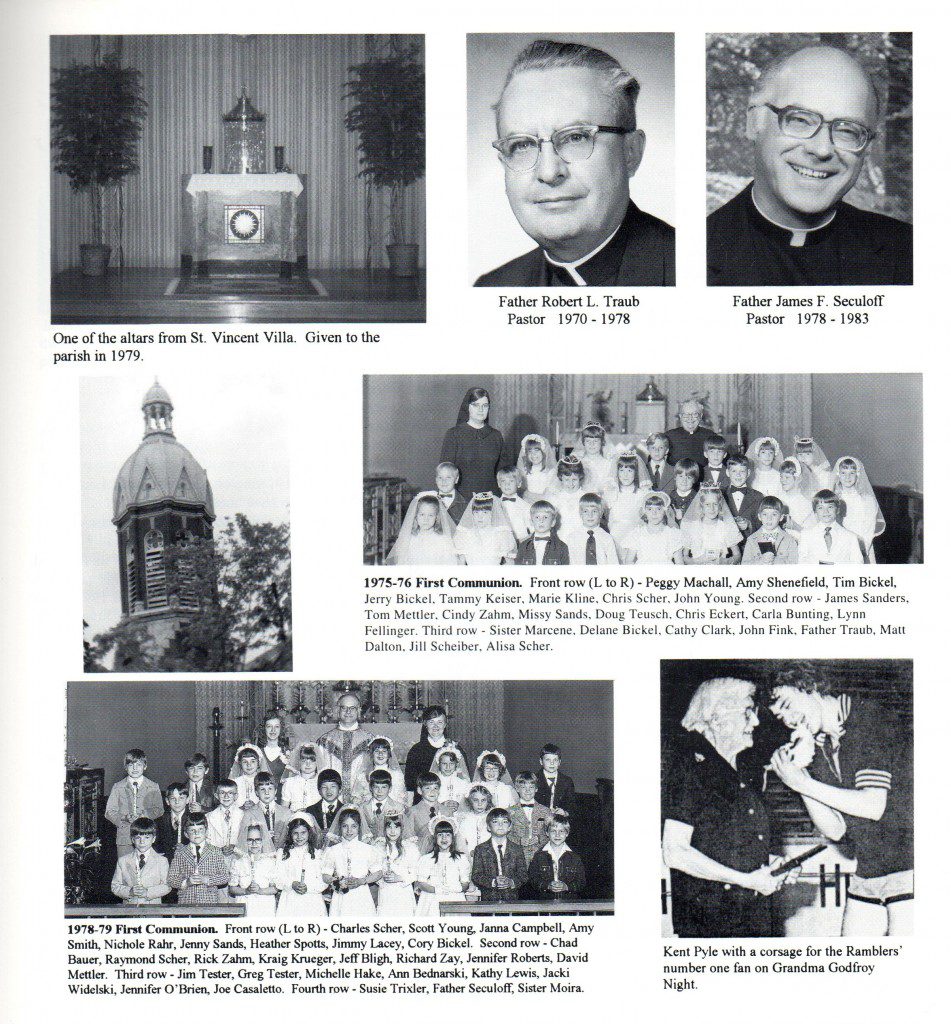
The new communal rite of Penance was introduced in the parish with services several times a year that included general examination of conscience, contrition and non-sacramental absolution for venial sins only. In 1977 the new rite of private Confession began in the parish. Confessionals were redesigned so that persons could choose to confess their sins in the traditional manner or face-to-face to the priest.
When St. Vincent’s Villa in Fort Wayne was closed in 1979 and the property sold, the marble altars in that chapel were given to St. Mary parish. Originally they had been chosen by Bishop Noll when he built the Villa.
In 1972 the City of Huntington provided adult patrol officers for all local schools, a practice that continued until 1994.
The parking lot was increased in size again in 1974 when the parish was able to acquire the Bippus property at the south end of the lot.
Timeline of events during this period: 1970 – Kent State students killed in Vietnam protest. 1971 – Indochina war spreads to Laos & Cambodia; Bishops synod in Rome reaffirms priesthood celibacy; Cigarette ads banned on TV. 1972 – Armed forces become all volunteer; Michelango’s “Pieta” damaged by fanatic. 1973 – Roe vs. Wade court decision legalizes abortion in U.S.; Arabs stop oil shipments; U.S. energy crisis. 1974 – President Nixon resigns. 1975 – Eliz. Seton canonized, first American-born saint. 1976 – AF Academy admits women; ends all-male tradition at U.S. academies. 1977 – Alaskan oil pipeline opened. 1978 – Ayatollah Khomeini promotes strife to topple Shah of Iran; Murder/suicide in Guyana of 917 members of Peoples Temple; Guttenberg Bible sold for $2M at N.Y. auction. 1979 – Egypt & Israel sign peace treaty; Panama takes over operation of Panama Canal.
The Eighties
“Welcome Neighbor,” a low-key evangelization program at the four Catholic churches of the County, had a series of Open House days in 1980 to make Catholicism better known in the communities. This was followed in 1981 with an ecumenical survey of the County sponsored by the local Ministerial Association.
Some of the joy of the Christmas Season was spoiled for the parish in 1981 when vandals entered the sacristy and stole sacred vessels.
During summer vacation in 1981, individual families of the parish adopted a room in the convent to paint and redecorate before the Sisters returned.
The decrease in the number of religious vocations continued to take its toll in local parishes. Catholic schools had to hire lay teachers at greater expense; tuition costs rose. Huntington Catholic High School started the BASH auctions in the early Eighties, selling more expensive, donated items to raise money. Volunteers from both parishes opened a second-hand clothing and appliance store, Ramblin’ Rose, in the business district with proceeds going to HCHS.
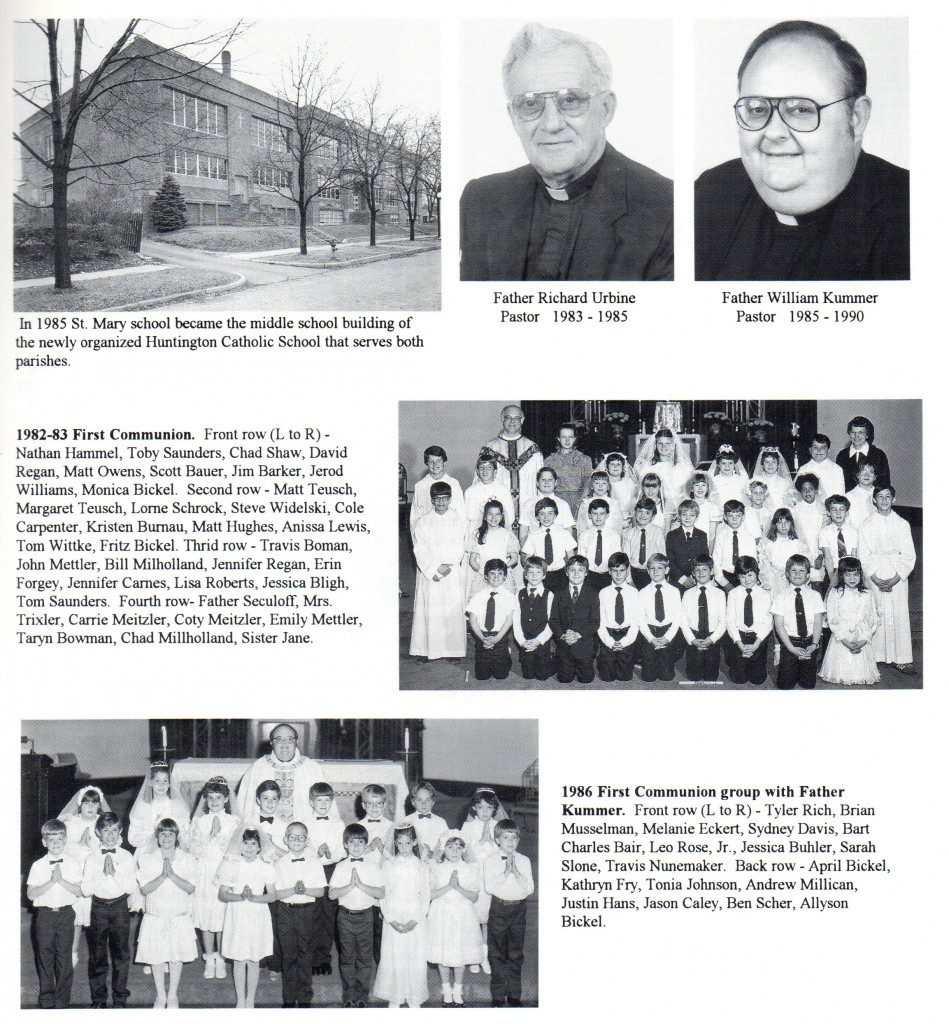
New state and federal laws required some changes in parish property. A ramp for the handicapped was built at the south entrance to the church in 1984, with another ramp inside the entrance to the gym. The asbestos insulation that was part of the school renovation in the Fifties had to be removed.
A greater percentage of Catholic students began going to the new public high school. This drop in enrollment plus always increasing costs for faculty and supplies led to the closing of Huntington Catholic High School in 1985. Pastors of the two parishes agreed to consolidate their elementary schools into one Huntington Catholic School, using both school buildings and staffs.
The permanent Deaconate was revived in the diocese and in 1984 St. Mary’s had the services of its first and only Permanent Deacon, Joseph Zickgraf, who served until 1991 when he was transferred to the Cathedral. It was also in the Eighties when seminarians of the diocese were sent to St. Mary’s and other parishes during the summer months for practical experience.
In 1987 the condition of the stained glass windows in the church necessitated a major cleaning and repair job that also added storm windows for protection and to save on heating bills. It was the start of a general renovation program in preparation for the parish centennial.
Timeline of events for this period: 1980 – Archbishop Romero murdered in El Salvador; Tito dies; Yugoslavia breaks into ethnic states; Lech Walesa leads Polish labor strike. 1981 – Iran releases U.S. hostages held 444 days; Assassination attempts on Pres. Regan, Pope John Paul II; AIDS disease begins taking toll in U.S. 1982 – Viietnam War memorial dedicated in Washington D.C. 1983 – Cabbage Patch dolls become black market item. 1984 – Britain signs agreement to transfer Hong Kong to China in 1997; U.S. halts funding of international birth control programs. 1986 – Ferdinand Marcos defeated in Philippines election; Seven astronauts killed inChallenger explosion; Singer Co. stops making sewing machines. 1988 – Bush-Quayle presidential campaign gets official start in Huntington. 1989 – Soviet bloc begins to break up; Berlin Wall demolished; Chinese students protest in Tiananomen Square; hundreds killed; Exxon Valdez oil spill in Alaska.
The Nineties
More changes were made in the liturgies in compliance with Vatican II; the effects of the slowdown in religious vocations continued.
A new Rite for funerals was introduced, replacing the provisional ritual that had been used since the Seventies. The main change was the introduction of a Scriptural Wake Service for use at the funeral home. Black vestments were no longer used at the funeral Mass. Emphasis was on the joy of the Resurrection and Eternal Life rather than on mourning.
Religious preparation for parents and godparents became more strict before infant baptism.
In 1993 a group of young people of the parish traveled to Denver to celebrate International World Youth Day with Pope John Paul II.
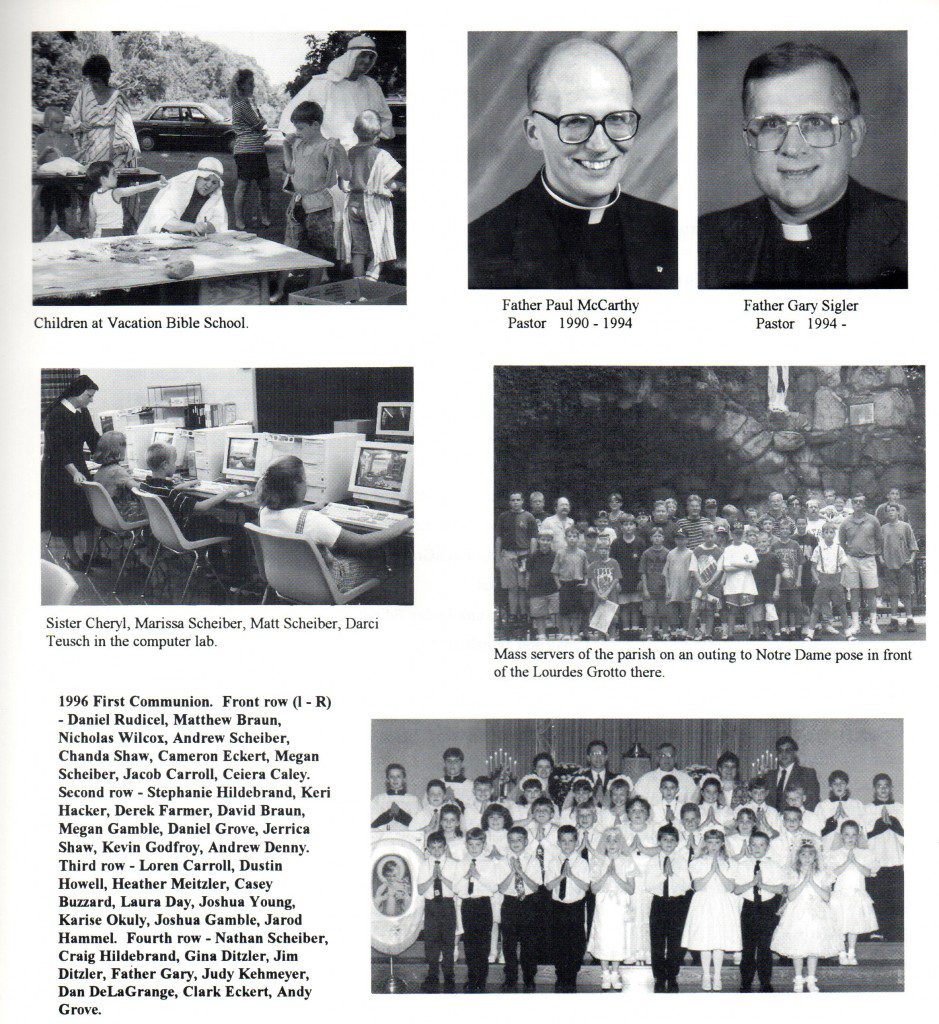
With only one priest assigned to the parish, the weekend Mass schedule at St. Mary was cut to just two Masses on Sunday and one on Saturday evening. In 1995 the pastoral workload was somewhat relieved with the hiring of Dan DeLaGrange as Lay Pastoral Minister to teach catechism, visit the sick and give instructions.
Life at Huntington Catholic School had changed also. Lay teachers staffed almost every position. The four Franciscan Sisters of St. Mary parish were the only religious in the school.
Gradual growth began to show in the parish census and in activities. Preschoolers and primary students were proud to take part in their own special collection at weekend Masses. Their money was used to install a new carillon system. Weekly Eucharistic Adoration begun at Victory Noll in 1995 was moved to St. Mary in May, 1996 when an Adoration Chapel was opened in the former baptistery.
A small group of volunteers spent almost a year repainting and redecorating the convent and its furnishings.
In 1992 the original sanctuary lamp was found and rehung. It brought a surge of interest and energy for a major renovation of the church. Through fund raisers, special collections and private gifts, families of the parish raised almost $700,000 in actual cash. They also donated thousands of hours of volunteer labor to provide repairs and modern equipment, updating the property that had received only emergency care for a number of years.
The entire inside of the church was painted and redecorated, pews and woodwork were stripped and refinished, kneelers recushioned, new roofs and gutters installed, brickwork tucked and pointed, air conditioning and carpeting added, and cement work repaired. Renovation began during the pastorate of Father Kummer, with most of the necessary projects taken on and completed during Father McCarthy’s term, and the job finished under Father Sigler in time for the anniversary.
On October 10, 1996 in the presence of Bishop John D’Arcy, the centennial observance of the parish began with a special Mass followed by a reception. It was the first activity planned for the year-long commemoration of one hundred years of parish life.
Timeline of events from this period: 1990 – Germany reunites; South Africa declared a republic, segragation outlawed. 1991 – Operation Desert Storm defeats Iraq in 100 hours; Sexual harassment becomes focus of public attention. 1992 – VP Quayle in “Murphy Brown” accusation spotlights Family Values; Johnny Carson retires from TV “Tonight Show”. 1993 – By executive order, Pres. Clinton liberalizes abortion; Shoot-out with Branch Davidians in Texas. 1994 – LA earthquake; Skater Tonya Harding instigates clubbing attack on rival, Nancy Kerrigan. 1995 – Channel under North Sea unites England & France; Baseball players strike. 1996 – Illegal immigration soars; Auction of Jackie Kennedy effects tops $34 M; Downtown Huntington floods; Terrorism grows worldwide.
Addendum
The first century of this parish included many activities and organizations that received little or no mention in the earlier pages of this history. Religious, charitable and social events filled those years and still continue.
On that list are church services such as Sunday Vespers, missions, retreats, Forty Hours, May processions; the work of Eucharistic ministers, lectors, choir, ushers, Mass servers; add Scout troops, school boards, study clubs, parish councils, Rosary circles, St. Vincent de Paul charities, adopt-a-family, prayer chains. There continue to be bake sales, bazaars, festivals, breakfasts, dinners, Bingo, raffles, fish frys, rummage sales; a long history of carry-in dinners, funeral dinners, Easter egg hunts, ice cream socials, picnics, outings, plus the old theatrical offerings, movies and athletic events. And don’t forget the special committees of volunteers to take on special projects: tarring roofs, repairing walls and cement, providing flowers, painting, papering, cleaning, sewing, etc., etc., etc.
It’s all part of parish life – family life on a grand scale.
Patrons:
Margaret Aufdenkampe
Kenneth and Shirley Bear
Elizabeth Belding
Patsy Bickel
Paul and Ruth Blomeke
Tim and Kathy Blomeke
Steve and David Blomeke
Marietta Boyer
Russell and Donna Brodrick
Michael J. and Deanne M. Bushee
Dave, Jan, Andy, & Colleen Carnes
Mr. & Mrs. Dan DeLaGrange & Family
Carolyn DeLuca
Tom, Michelle and Jordan Edington
David and Saundra Ellet
Dale and Dana Flora
Marvin and Patricia Hay
Mr. and Mrs. William I. Howell
Mrs. George M. Keefe
Paul and Ruth Kline
Mr. and Mrs. Jack Lippincott
Mary Machall
Joseph J. Manoski
Eldon & Roberta (Young) Meitzler
Edward and Rebecca Merckx
Mr. and Mrs. John P. Overman
Mary and Dick Paine
Jeff and Jo Paul
Andrea and Adam Paul
Joanne Pyle
Robert and Anna Richardson
Wayne and Janet Scheiber
Bernard J. and Patricia A. Scher
Mr. and Mrs. Kevin Scher
Rita A. Shideler
Don and Mary Lou Smith
Audrey Thompson
Carleton L. and Rosalyn C. Trook
Ann I. Tuttle
Karen and Joe Wixted
Mr. and Mrs. James Young
Mr. Mrs. Jeffry Young
Mary Ann Young
John Young
Thomas Young
Mary Joline Young
Pastors of Saint Mary:
Father John R. Quinlan – 1896-1910
Father John Durham – Interim Pastor – 1901
Father John Noll – 1910-1925
Father Robert E. Kelly – 1925-1932
Father Thomas E. Dillon – 1932-1953
Father Edward A. Miller – 1953-1962
Father James J. O’Conner – 1962-1968
Father Raymond Balzer – 1968-1970
Father Robert L. Traub – 1970-1978
Father James F. Seculoff – 1978-1983
Father Richard Urbine – 1983-1985
Father William Kummer – 1985-1990
Father Paul McCarthy – 1990-1994
Father Gary Sigler – 1994-2005
Father John F. Pfister – 2005-2015
Father Stephen E. Colchin – 2015
Associate Pastors, Volunteer Priests, Deacons, Lay Pastoral Associate
Father Voelman – May – Sept. 1908
Father John F. deVille – June-July 1913
Father George Moorman – 1914-1916
Father Leo Faurotte – 1916-1917
Father Robert E. Kelly – 1917-1925
Father Thomas E. Dillon – 1925-1932
Father Bernard Bourke, O.F.M. CAP. – 1931-1933
Father Ivo Weindl, O.F.M. CAP. – 1932
Father Edwin Modicowitz, O.F.M. CAP. – 1933-1935
Father Alvin Lafeir, O.F.M. CAP. – 1935-1937
Father Gabriel Diefenbach, O.F.M. CAP. – 1937-1939
Father Kenneth Barnes, O.F.M. CAP. – 1939-1940
Father Joseph A. Klinker – 1941-1945
Father William Lester – 1945-1951
Father John Reed – 1951-1958
Father Lawrence O’Toole – 1958-1959
Father James R. Rose – 1959-1961
Father Raymond J. Balzer – 1961-1963
Father Frank Kronewitter – 1963-1968 & 1986-1992
Father Barry C. England – 1968-1971
Father Richard P. Hire – 1971-1973
Father Thomas A. Lombardi – 1975-1984
Father Edward D’Souza – May-July 1992
Father Lionel Fernando – April – Dec. 1993
Father Robert Fosselman – 1994 – 2003
Deacon Joseph Zickgraf – 1984-1991
Mr. Daniel DeLaGrange – 1995-
Vocations to the Priesthood from Saint Mary’s:
Father Edward Fallon
Father Joseph Wonderly
Father Harold Moran
Father Nelson Sullivan
Msgr. Stanley Manoski
Father Edward Holland
Father Robert Fosselman
Father David Fosselman
Father Robert Zahn
Father Paul Miller
Msgr. Raymond Fowerbaugh
Father Patrick McNulty
Men Religious Vocations from Saint Mary’s:
Brother James Scher, O.S.C.
Brother Mark Carrico, OFM Cap.
Vocations to the Sisterhood from Saint Mary’s:
Sister Mary Celine Martin, O.S.F.
Sister Mary Marita Stoffel, O.S.F.
Sister Mary Doretta Kennedy, O.S.F.
Sister Mary John Francis Hipskind, O.S.F.
Sister Mary Regina Kavanaugh, C.S.C.
Sister Mary Roberta Young, S.P.
Sister Mary Celine Clark, S.S.J.
Sister Mary Ida Schenkel, O.S.F.
Sister Mary Agnes Marie Regan, O.S.F.
Sister Mary Urbana Young, S.S.N.D.
Sister Mary Joan Marie Siemik, O.S.F.
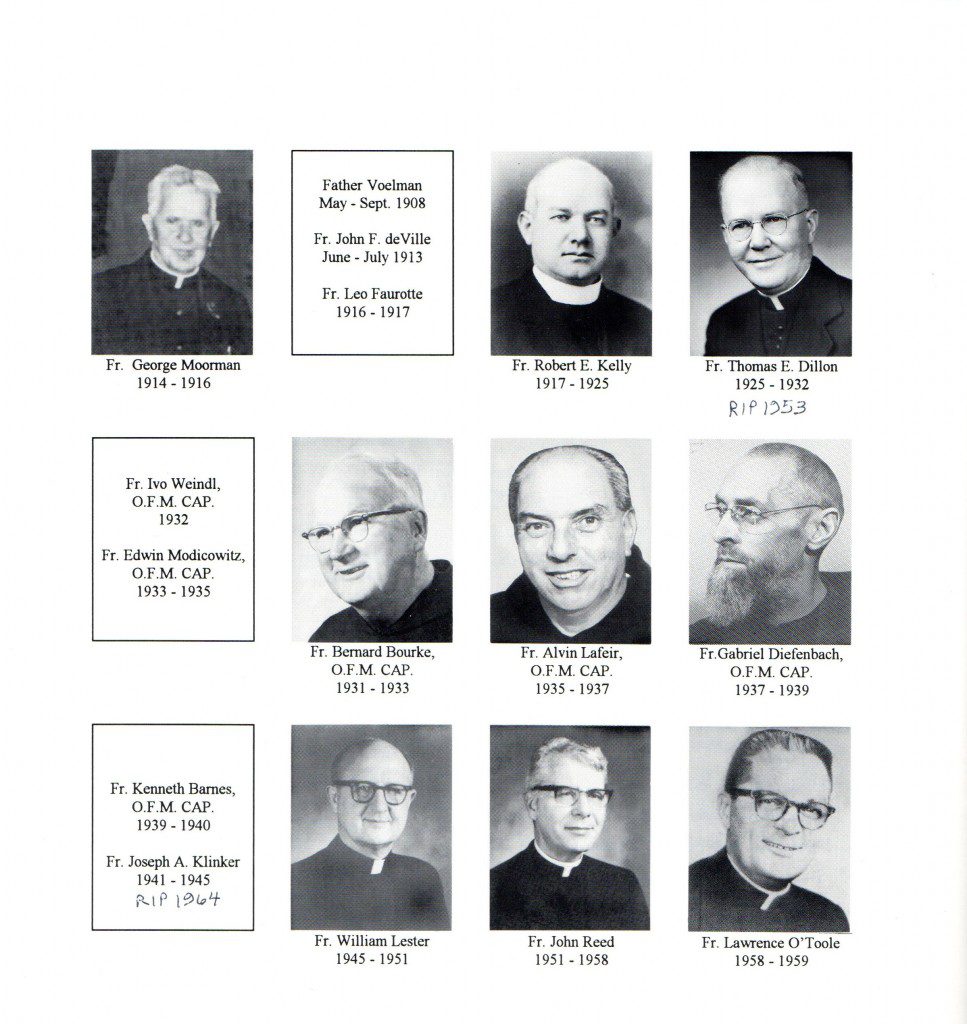
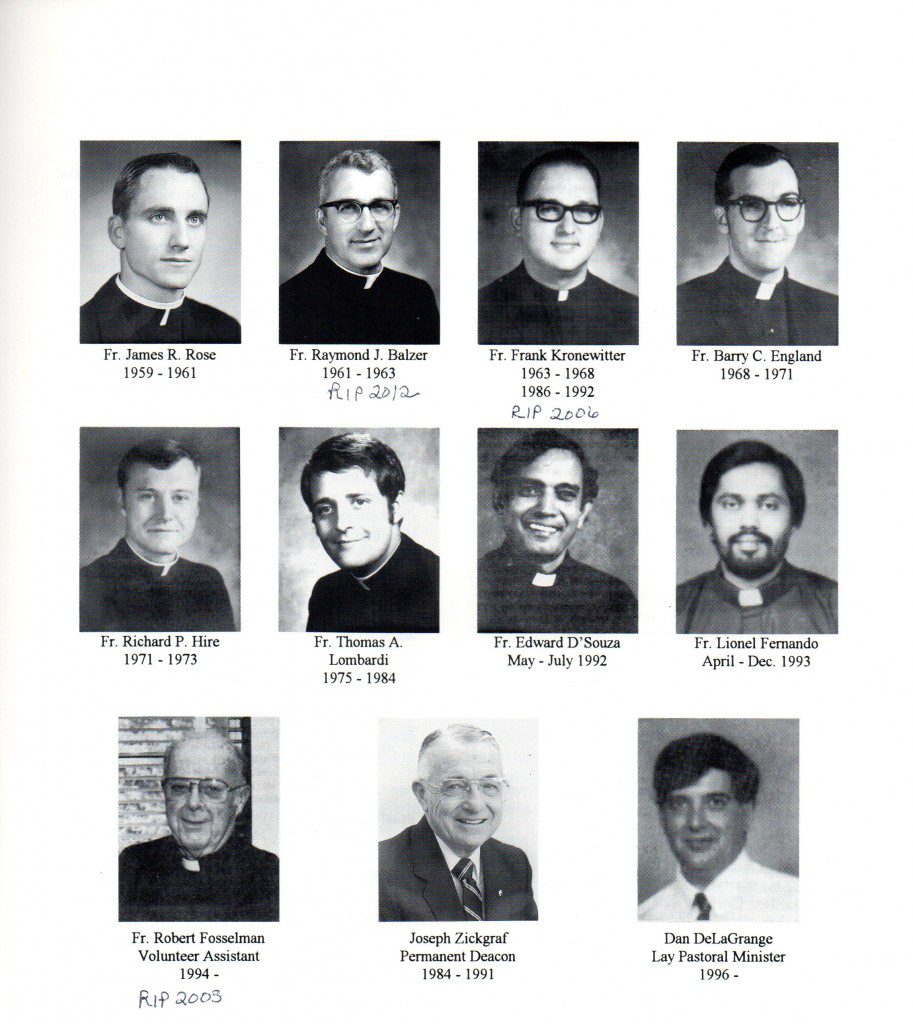
Parish Trivia:
When St. Mary school was opened in 1897 it consisted of just one large room in the Roche building downtown. The 116 students had classes there until the new four-room building was ready in the spring of 1898. Tuition was $.50 a month. The place was heated with wood-burning stoves.
Lawrence Eisenhauser was one of the men in 1921 who hauled sand from Tipton and Dimond Streets to make plaster for the addition to the school. Boards in the wagon beds could be tipped on end so that the sand would empty without shoveling. But sometimes the boards were moved accidentally and the wagon was empty by the time it reached the building site.
That bricked-up entrance to the gym on the south side was used at one time. It came into the building right below the stairway that now leads up to the gym balcony.
When Herman Bir painted the Assumption mural above the sanctuary in 1917, he used the face of one of his children to portray a cherub in the scene.
During Father Kelly’s time as pastor, children arriving late for weekday Mass were sure to go into the church immediately. They knew that anyone hanging around outside was likely to get a personal and embarrassing escort inside by the pastor himself. Try explaining THAT to Sister.
St. Mary’s students of earlier years remember the restrooms in the basement. There were stairways inside the building but students were expected to use the outside stairways to get to the basement, even during cold weather.
A stage was built inside the gym on the west side for plays, recitals, etc. Bleachers were placed on the stage for basketball games.
The book rental system was introduced at school in 1940. Each child paid $.25 a month for the use of books. In addition a yearly fee of $1 was asked for subscription to the Young Catholic Messenger and for art supplies.
Curious about what’s under the church building? About one-third of it (under the sacnturary and part way into the nave) is excavated. There’s also a path to the west end of the basement for maintenance of a third heating unit.
Jefferson Street and others on the north side of the river were level with the lawns at the top of the hill. The grade proved to be too steep, especially for the new cars being invented. The street was dynamited and excavated to lower it. That’s why there are embankments of lawn in front of the buildings. After putting in the new road bed, Jefferson was paved with brick in 1896.
Nick Scheer, grandfather of Dick and Leo, built the grotto about 1915. Some of those stones weigh about a ton. To achieve the arched ceiling, it’s probable that earth was piled up to make the form, the stones dragged up and cemented in. When that was dry, the dirt was removed and the arched ceiling was in place. Dick and Leo were charged by their father to keep the grotto in repair and have done so in tribute to their grandfather.
The marble pillars in the church are load-bearing and go down to the basement floor. The shafts seem to be in two sections; lower half below the church floor, upper half to the capital supports of the ceiling arches. The pillars were imported from Italy, were dragged up Jefferson hill by horses to the building site.
The Rosary Society published a cookbook in 1976 with favorite recipes of parishioners. Price was $3.50 a copy.
During the years of the big depression in the Thirties, Sisters teaching in Catholic schools of the diocese received only the money given in the children’s collections. It averaged about eight dollars a month!
The statue of the Blessed Mother on her side altar is the only wooden statue in the church. All the other large statues are of plaster and came from France.
In 1943 the parish gave its high school teachers a raise – to $40 per month! Salaries were raised to $50 in 1952.
Back in the horse and buggy days of the parish there were feed barns at the present YMCA corner and the old OSV building on Park Drive. In very cold weather, horses were kept there during church services and other parish activities.
When the old high altar was removed in 1950, Father Dillon told the contractor, Carl Kitt to burn it. The wood was so dry it was like tinder and produced an exceptionally hot and fast fire.
Back in the Twenties, Father Kelly promoted girls’ basketball (using boys’ rules). Games were played at the K of C hall where side pillars form an interesting obstacle course. Uniforms? The famous black bloomers and middy bouses.
During the redecorating of the church in 1950 quite a few statues and other appointments were discarded in favor of a simple, modern decor. The Capuchins at the monastery were given first choice of the discards. Whatever was left was placed in the parking lot and could be taken by parishioners.
In the early years the parish had it own greenhouse in the area of the present heating plant on the west end of the school. There was also a tennis court where the gym now stands. During the expansion program in 1921 there was some discussion of putting a swimming pool below the gym.
Take a look at the window in the choir loft. That and those in the vestibules and a few other small ones are original to the church. Those in the nave were replaced by Father Noll with the present stained glass windows, most of them depicting events concerning the Blessed Mother. The windows of the Four Evangelists in the sancturary are of slightly different design and could be from 1897.
A landmark decision of the U.S. Supreme Court was made in the case of an early parishioner. Lambdin P. Milligan led an armed uprising in N.E. Indiana against the Union during the Civil War. He was tried by a military court, sentenced to be hanged. In his appeal the Supreme Court agreed that, as a civilian he could not be tried by a military court as long as the civil court system functioned. He returned to Huntington, continued his law practice. He was buried from St. Mary’s in 1899.
The table top of the original high altar was a large slab of stone. It had to be removed in 1950 to make way for a new wooden altar table that required just a small stone insert at the center. The old stone slab was too large and much too heavy to move any distance. It was lowered through the floor, directly into the basement and is still there.
Some of the longtime parishioners can remember that the first quiz of the school day asked about daily Mass…what the Gospel was about, how many candles were burning on the altar, who was the celebrant?
The annual school picnic was held at the George Eisenhauer farm (now Victory Noll). Date was always Ascension Thursday and it usually rained!
One of the early students at St. Mary’s went on to literary fame. H. Alan Smith was more interested in writing than studying. He left school, got a job at the local newspaper and then moved on to New York. Among his books was the best-seller, “Low Man on a Totem Pole.”
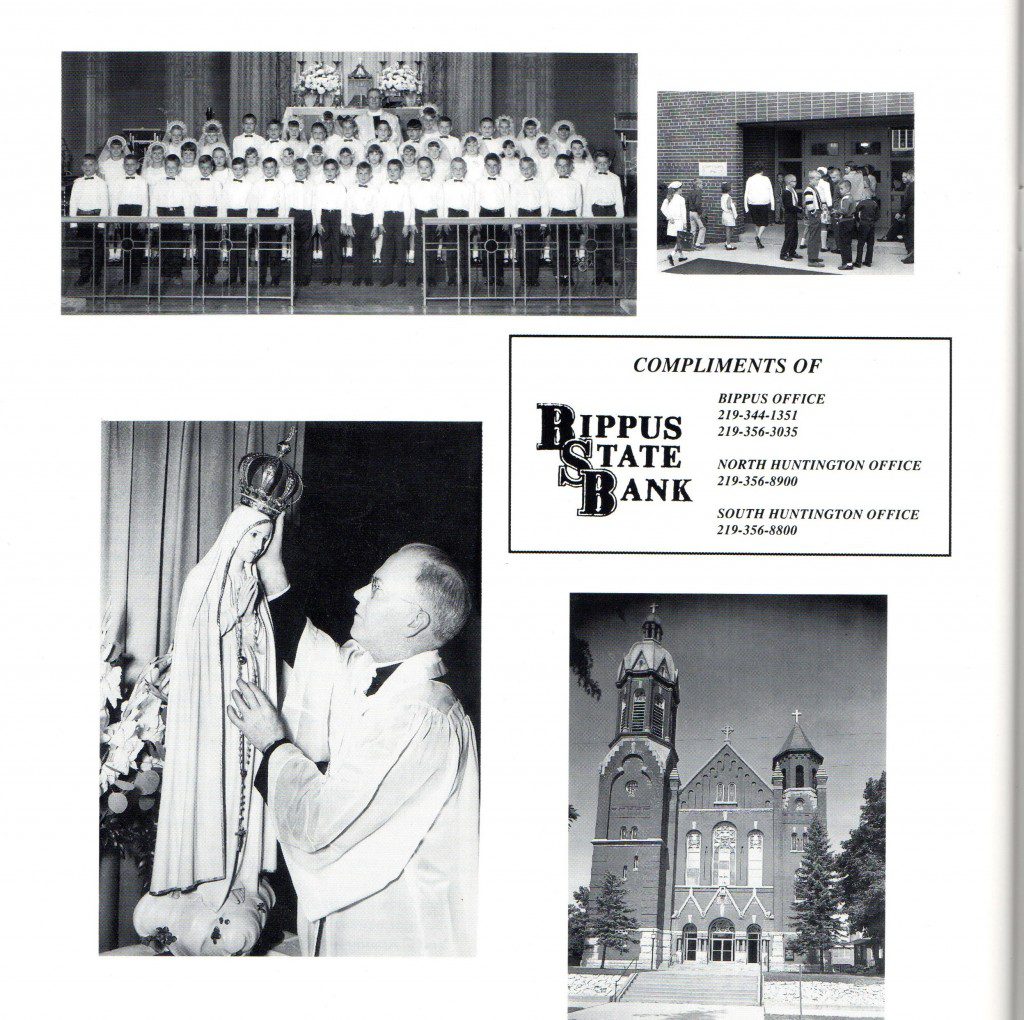
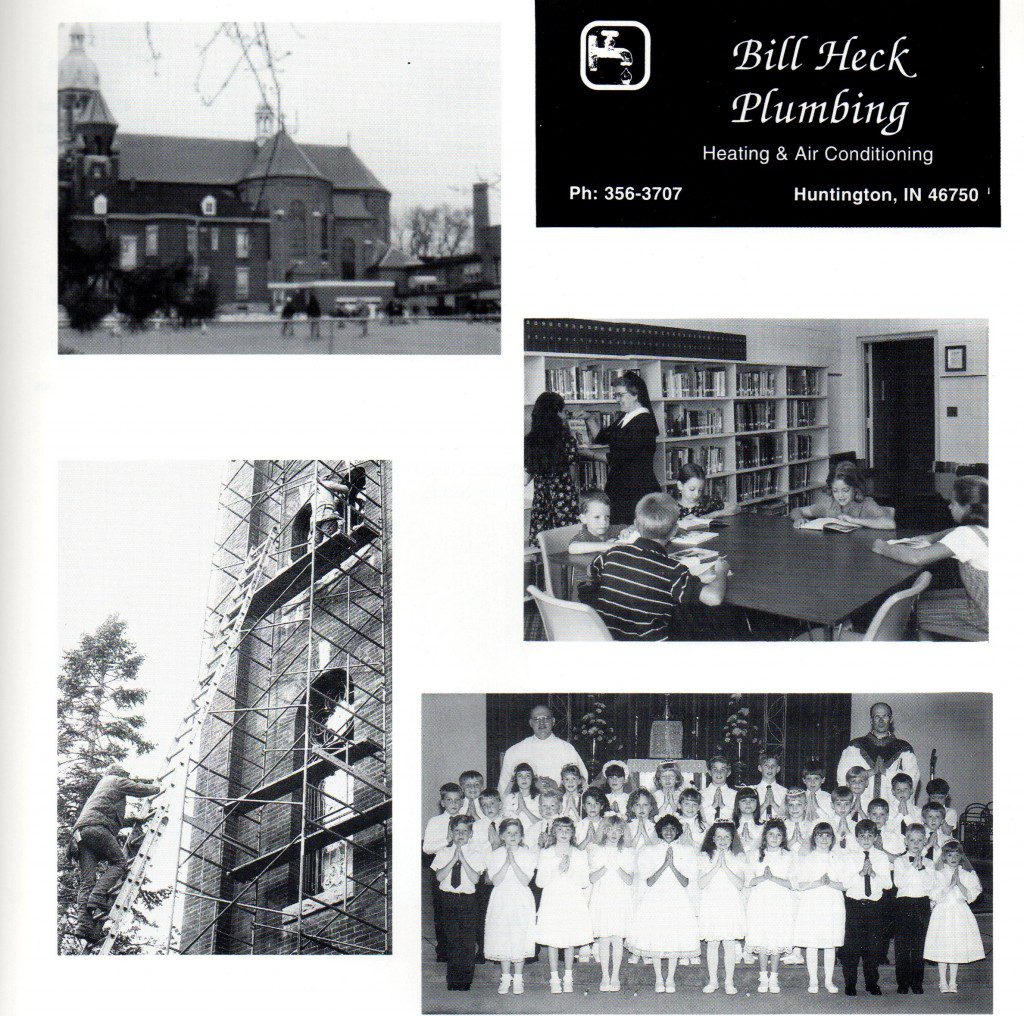
Acknowledgements:
Gathering material to cover one hundred years of history involves a lot of detail work. This book was made possible by the generous help of a good many people.
Thanks to those who verified information, helped to identify old file pictures or corrected dates. Seemingly just bits and pieces, but they provided color and authenticity. Parishioners who gave financial help are also owed a debt of gratitude for getting this project off the ground.
With an apology in advance if anyone who made a major contribution to the book is overlooked here, mention must be made of knowledge shared by Jean Gernand of Forks of the Wabash, Joan Keefer at the Indiana Room of the library, Margaret Venderley at the Cathedral Museum in Fort Wayne, and Father Thom Lombardi’s preliminary work on the parish archives. Jane Zahm provided old pictures as did Florence Zahm and Bill Christman. Other pictures came from Sister Moira, Martha Bickel, Jane Hatton, David Shideler, and Today’s Catholic. Sue Strass, Paul and Evelyn Godfroy gave information on the Miamis and the LaFontaine family; memories of the earlier years in the parish came from Virginia Gibler, Stella Bir, Florence Zahm, Fritz and Rose PeGan.
Joe Hunnicutt provided professional advice and encouragement; Jeff Johnston helped on art work; John Shields did some special photographic work. Jerry Campbell shared his vast knowledge of the buildings. Father Gary, Dan DeLaGrange and Patsy Bickel provided a clearing house at the rectory to funnel needed information.
A nod of appreciation goes to Kathy VanGilder, Dave Worthen and their phone committee who convinced a good number of advertisers that the book would be worth an investment.
Biggest thanks of all to Sue Forgey (and her family) for the hours of computer time she gave to make the book a reality. Then it was put into the hands of Mark Baumgartner and Vicky Thompson of The Papers staff who gave it a final polish and shepherded it through to publication.
Putting it all together was challenging, exciting…and sometimes frustrating. Hopefully the book provides good information that readers will find interesting and of some value.
Staff
Editors: Murray Hubley & Loretta Manoski
Typesetting and Layout: Sue Forgey
Photography: Murray Hubley
Advertising: Kathy VanGilder & Dave Worthen
Source Material
Alerding, Herman – “History of the Fort Wayne Diocese”
Ankenbruck, John – “Voice of Little Turtle”
Bash, Frank S. – “History of Huntington County”
Blanchard, Charles – “History of the Catholic Church in Indiana”
Esarey, Logan – “A History of Indiana”
Francis, Dale – “Our Town” columns, Huntington Herald Press
Griswold, B.J. – “Pictorial History of Fort Wayne”
Hubley, Murray – “A History of St. Mary Parish”
Noll, John – “The Diocese of Fort Wayne”
Rectory Archives
Trager – “Peoples’ Chronology”
Wetterau – “New York Public Library Book of Chronology”
